 Open Access
Open Access
REVIEW
Mechanical Properties and Durability of Sustainable Concrete Manufactured Using Ceramic Waste: A Review
1
School of Water Conservancy Engineering, Zhengzhou University, Zhengzhou, 450001, China
2
Communications Construction Company of CSCEC 7th Division Co., Ltd., Zhengzhou, 450004, China
* Corresponding Author: Yuanxun Zheng. Email:
(This article belongs to the Special Issue: Sustainable Concrete with Recyclable Materials)
Journal of Renewable Materials 2023, 11(2), 937-974. https://doi.org/10.32604/jrm.2022.023290
Received 19 April 2022; Accepted 19 May 2022; Issue published 22 September 2022
Abstract
Green and sustainable concrete has attracted significant attention from the construction industry and researchers since it was proposed. The ceramic waste materials are often directly buried in the ground or placed in an open dump, and the accumulation of ceramic waste contributes to environmental pollution, which makes the recycling of ceramic waste quite urgent. Owing to the pozzolanic activity, excellent mechanical properties and durability, industrial ceramic waste is considered as a suitable substitute for cement or natural aggregates to fabricate renewable concrete. In this paper, the pozzolanic activity of ceramic waste and the workability, mechanical performance, and durability of ceramic concrete are discussed. In addition, the most recent research results pertaining to ceramic concrete are reviewed. Ground ceramic powder improves the workability, compressive strength, resistance to chloride penetration, and carbonation resistance of concrete to a certain extent. Concrete containing ceramic as the aggregate has a lower mechanical performance than ordinary concrete. However, the resistance to chloride penetration, freeze-thaw resistance, and high-temperature resistance of ceramic concrete are remarkable. Ceramic concrete is environmentally friendly, requires fewer energy resources to manufacture than ordinary concrete, and has excellent engineering properties. However, further research is required for future engineering applications.Keywords
Concrete is a widely used and man-made building material owing to its accessible shapes and sizes, high strength, and good durability. However, as a crucial part of concrete, cement can consume a large amount of resources and energy in the production process, leading to high emissions of carbon dioxide (CO2), which is considered a greenhouse gas [1]. Moreover, with the rapid development of the construction industry and urbanization, natural aggregate resources are being exploited in large quantities owing to the increasing demand for concrete [2,3]. The risk of depletion of natural resources and environmental pollution in the mining process has increased as a result [4,5]. Therefore, the development of greener and more sustainable concrete is essential for reducing CO2 emissions and protecting nature [6].
The recycling of industrial waste to manufacture concrete can not only protect the environment owing to the reduction in accumulated industrial waste, but also results in economic benefits as it reduces the production costs of concrete [7,8]. Ceramic waste has been extensively studied as an industrial by-product in recent decades. The ceramic waste (Fig. 1) investigated in these studies mainly contained sanitary ware (toilets, urinals, and sinks), tableware (plates, bowls, and cups), electrical insulators, ceramic tiles (wall, floor, and roof tiles), and brick, which generally originated from defective production in the production process, breakage during transportation or utilization, and the demolition of buildings. These ceramic waste materials were often directly buried in the ground or placed in an open dump [9]. Ceramic waste has high strength and durability, and decomposes with difficulty [10]. The continuous accumulation of ceramic waste contributes to environmental pollution, which makes the recycling of this waste quite urgent.
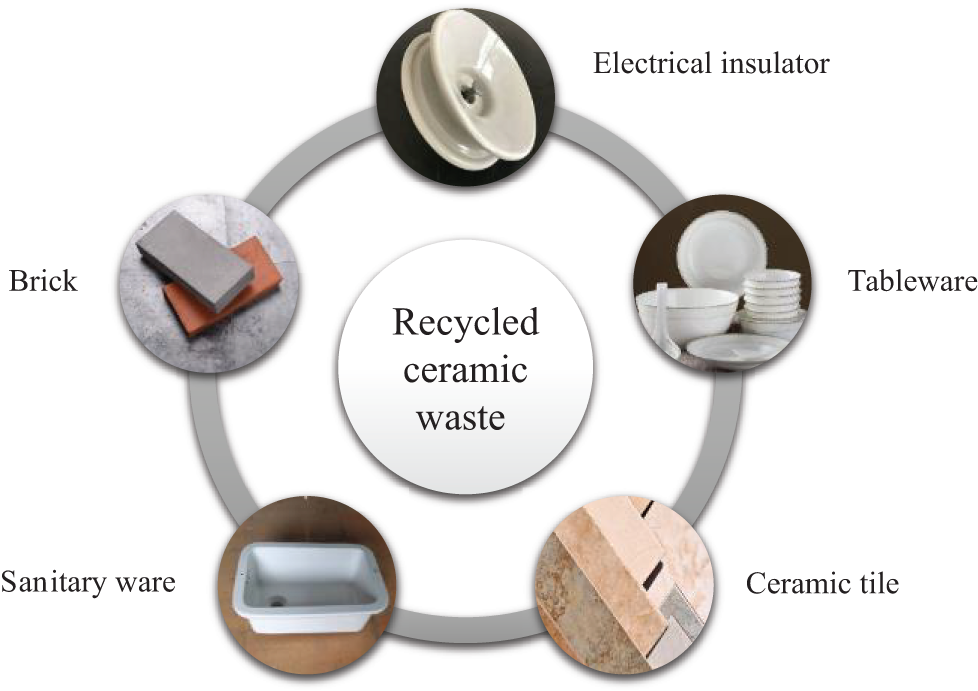
Figure 1: Types of ceramics available for recycling
Ground ceramic waste powder (CWP) had pozzolanic activity and could replace cement in concrete [11]. According to statistics, replacing 20% of the cement in concrete with CWP could reduce the specific energy consumption of cement preparation by 6.62% [7]. The strength and durability of concrete with CWP as a partial substitute for cement had been tested in some studies [12–15]. The substitution ratio is a vital factor affecting the properties of ceramic concrete. For example, the strength and carbonation resistance of concrete with ceramic powder substitution rates of less than 30% were excellent [13]. Research on the use of ceramic tile waste powders to produce high-performance concrete (HPC) indicated that they reduced the strength of HPC, but the resistivity and resistance to chloride ion permeability were significantly higher than those of concrete without ceramic tile waste powders [3,16]. In addition, the influence of ceramic waste type on performance of concrete was investigated. These results suggested that the compressive strength of concrete containing ceramic waste powder of sanitary ware was higher than that of concrete containing ceramic tile waste powder, because the pozzolanic activity of ceramic sanitary ware waste powders was better than that of ceramic tile waste powders [17]. The use of mineral admixtures to improve the properties of ceramic powder concrete is also extremely effective.
At the same time, ceramic waste exhibited enormous potential as a concrete aggregate (coarse aggregate or fine aggregate) owing to it strength and durability [12,18,19]. Pacheco-Torgal et al. [20] investigated the strength and durability of concrete containing ceramic waste aggregates. The replacement of 25% of the natural coarse aggregates in concrete with crushed ceramic waste resulted in 11% [21] and 19.7% [22] increases in the 28 d compressive strength of concrete. However, it had also been reported that addition of ceramic waste aggregates to concrete led to a reduction in the compressive strength of concrete regardless of the percentage of the addition [23,24]. These results might be attributed to the different types of ceramic waste used in the studies. It was observed that pretreatment (soaking in a special solution or water or removing the smooth surface) of ceramic aggregates could improve the mechanical performance of concrete [25–27]. The special solution with appropriate concentration could corrode surface of ceramic aggregates, resulting in an increase in bond strength between aggregates and pastes and compactness of interface transition zone. The method of removing smooth surface of ceramic aggregates also improved the bonding between aggregates and pastes and increased mechanical strength of ceramic concrete. The aggregates soaked in water released water at the later age, promoting the pozzolanic reaction of ceramic aggregates and generating more C-S-H gels. The influence of silica fume and metakaolin on the mechanical performance and durability of coarse ceramic aggregate concrete had also been studied in detail [28]. Unlike ceramic waste powder, coarse ceramic aggregates resulted in an increase in the water absorption and chloride ion permeability of concrete [22,29]. Moreover, ceramic concrete is highly resistant to high temperatures [30–33]. Thus, it is feasible to use ceramic waste in concrete. This is conducive to the development of greener concrete and reduction in environmental pollution [34,35].
Ceramic concrete has been studied by many researchers. However, there are few comprehensive reviews on the performance of ceramic concrete. To understand the research and development of ceramic concrete more extensively and deeply, it is necessary to integrate the existing literature. This study focuses on ceramic waste as an alternative to cement, fine aggregates, and coarse aggregates in concrete. Detailed descriptions of the workability, compressive strength, tensile strength, flexural strength, elastic modulus, water absorption, resistance to chloride ion penetration, freeze-thaw resistance, high-temperature resistance, and carbonation resistance of ceramic concrete are presented. This provides a basis for future research on ceramic concrete.
2 Pozzolanic Characteristics of Ceramic Waste
The oxides of ceramic waste had been observed by energy dispersive spectroscopy (EDS) and X-ray fluorescence (XRF) [36]. The chemical compositions of cement and ceramic waste are presented in Table 1. Silica (SiO2) and alumina (Al2O3) are the main components of ceramic waste. In terms of oxide content, if the mass fraction meets the requirements of ASTM C618 [37], that is, SiO2 + Al2O3 + Fe2O3 > 70%, the ceramic waste is considered a potential pozzolanic material. As shown in Table 1, in addition to tableware, sanitary ware, electrical insulators, ceramic tiles, and bricks can all meet the demand for ceramic waste. However, this does not mean that tableware does not have pozzolanic activity.

The pozzolanic activity of ceramic waste can be tested by the Frattini test [3,42], saturated lime test [40], and strength activity index [36,43,44]. The sample for the Frattini test is prepared with 4 g ceramic waste, 16 g ordinary Portland cement and 100 g distilled water [45]. Data points of test results on or above saturation curve have no pozzolanic activity, while those below saturation curve have pozzolanic activity. As shown in Fig. 2, the points of ceramic tile waste powders (CTWP) and fine tableware waste aggregates (FTWA) are under the curve. This proves that ceramic tiles and tableware have pozzolanic activity. In addition, the following three methods are also used to demonstrate the pozzolanic activity of ceramic waste: (i) Analyzing the presence of the amorphous quartz phase of ceramic waste by X-ray diffraction (XRD) pattern [46,47]; (ii) analyzing the change in calcium hydroxide (Ca(OH)2) contents in mixes by scanning electron microscopy (SEM) [43,48]; and (iii) analyzing the change in calcium carbonate (CaCO3) and Ca(OH)2 contents in mixes by thermogravimetric analysis (TGA) [11].

Figure 2: Results of a frattini test. Adapted with permission from reference [40], Copyright © 2018, American Society of Civil Engineers, and reference [48], Copyright © 2021, Elsevier B.V.
In the study of Awoyera et al. [46], the amorphous phase other than crystalline quartz phase was found at 2θ = 23–35o. This proved the pozzolanic activity of ceramic powders. The active components such as Al2O3 and SiO2 of ceramic powders reacted with Ca(OH)2 to form C-S-H gels, ettringite and other hydration products [7]. The SEM images of mixture of cement and ceramic powders cured for 7 d are shown in Fig. 3. It is obvious that Ca(OH)2 crystal is surrounded by C-S-H gels network which also contain ettringite crystal.

Figure 3: SEM images of mixture of cement and ceramic powders for 7 d. Adapted with permission from reference [46], Copyright © 2017, Informa UK Limited
3 Workability of Concrete with Ceramic Waste
Concretes with three grades of cement and CWP partially replacing cement presented a slight increase in slump values compared to the control specimen [13]. This was because fine ceramic waste particles filled in concrete pastes caused more free water to be released. This was confirmed in another study, which showed that the slump was greatly reduced when the cement was replaced by more than 20% CWP. Excessive CWP could absorb a large amount of free water, leading to a decrease in workability [15]. In addition, CWP had also been added to HPC [3] and self-compacting concrete (SCC) [11,49]. Fig. 4 shows the slump results of HPC with CWP replacement (10%–40%). The initial slump of the concrete with 30% and 40% replacement levels of CWP was less than that without CWP because CWP had a higher specific surface area than cement [50]. However, the slump retention time of HPC with CWP increased compared to that of the control concrete after 60 min. Slump retention improvement was attributed to a slow pozzolanic reaction and the lack of a hydraulic reaction for CWP [36]. When CWP was used in SCC, its slump flow decreased with the replacement of CWP owing to its high specific surface area [51,52]. However, with CWP partially replacing cement, the slump flow of self-compacted alkali-activated concrete containing ground blast furnace slag was higher than that of the control concrete. This could be attributed to the low specific surface area, large particle size distribution, and low water demand for CWP compared to ground blast furnace slag [53].
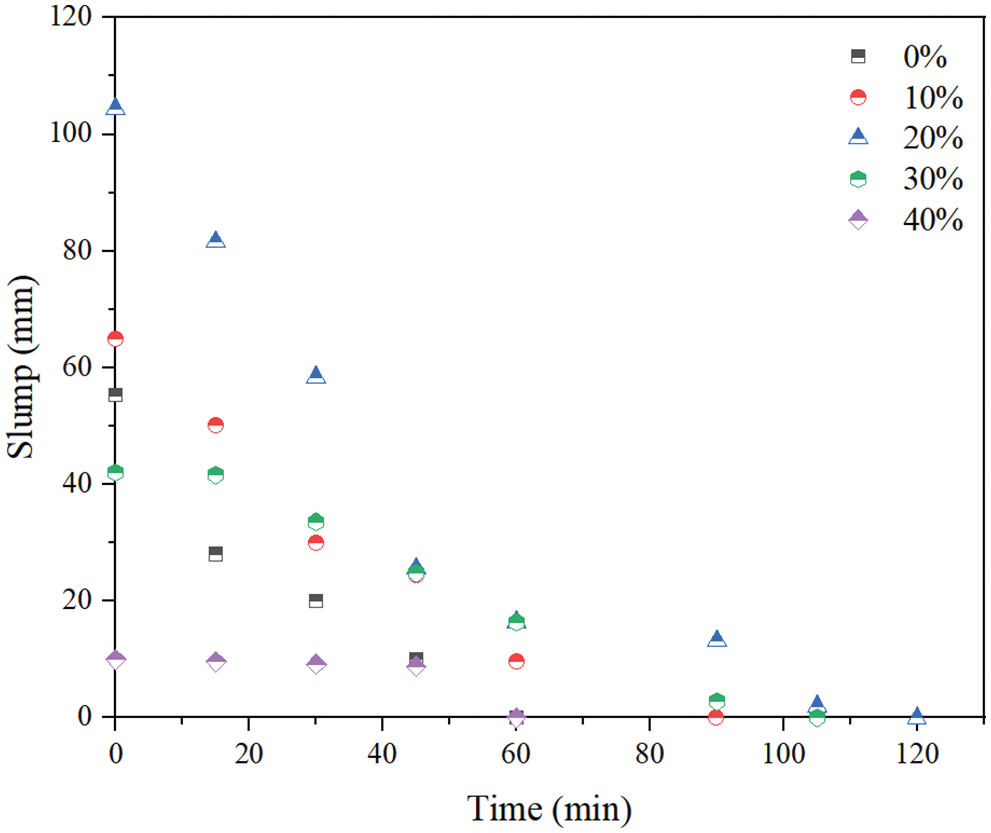
Figure 4: Slump of HPC containing different CWP contents with time. Adapted with permission from reference [3], Copyright © 2017, Elsevier B.V.
In general, ceramic waste partially replacing aggregates (fine aggregates and coarse aggregates) in concrete can lead to a decrease in slump or slump flow [54–58]. This may be attributed to the more irregular shape [59,60], rougher surface texture [59,61], and higher adsorption [61,62] of ceramic waste in contrast with natural aggregates. In order to reach the expected workability, it was recommended to add moderate water reduction additives to concrete [29,56,63]. However, some studies had reported contradictory results. Peter et al. [62] obtained 3%, 14%, and 22% increases in slump in concrete incorporating ceramic tile fine aggregates as substitutes for 25%, 50%, and 75% sand, respectively. Ceramic aggregates absorbed additional water to overcome the high water absorption before being added to the concrete. Moreover, Canbaz [64] reported that the higher slump of concrete was corresponded with the higher sanitary ware coarse aggregate content. In particular, when natural aggregates were completely replaced by ceramic waste, the slump increased by 20% compared to that of the control concrete. The improved workability of concrete was probably attributed to the lower surface area of sanitary ware waste than crushed stone, which was covered by more water layers when water remained unchanged.
The effects of fly ash on ceramic waste concrete were also investigated. As shown in Fig. 5, the slump of coarse ceramic tile aggregate (porcelain and semi-porcelain) concrete increases with an increase in the fly ash substitute level of cement [65]. When content of fly ash is 20%, the slump of concrete containing coarse ceramic aggregates increases by about 50%. The smooth-surfaced fly ash particles envelop aggregates and reduce friction between pastes and the aggregates. Therefore, the workability of the ceramic concrete is improved. Torkittikul et al. [10] obtained similar results. However, it was reported that the slump of coarse ceramic aggregate concrete containing fly ash and silica fume was lower than that of coarse ceramic aggregate concrete containing only fly ash. The very small particle size of silica fume caused concrete mixture to thicken, which reduced workability of concrete.

Figure 5: Influence of fly ash content on slump of ceramic waste aggregate concrete. Adapted with permission from reference [65], Copyright © 2014, China Academic Journal Electronic Publishing House
4 Mechanical Properties of Concrete with Ceramic Waste
Concrete is commonly under pressure; therefore, its compressive performance is extremely significant. Some related research results had revealed that partial substitution of the cement added to concrete with CWP could lead to a decrease in compressive strength, especially in the early stages of curing. As shown in Fig. 6, the compressive strength at 7 d and 28 d decreases with the content of CWP [16,66,67]. When CWP replaces 25% of the cement, the 7 d and 28 d compressive strengths are 26.35% and 24.58% lower, respectively, than that of the control concrete. It was observed that the compressive strength of concrete containing CWP at older ages of curing (56 d and 91 d) was similar to that of the control sample [20,66]. This was probably due to pozzolanic reaction of CWP and increase in C-S-H gels at older curing age [17]. However, the pozzolanic activity of CWP resulted in denser concrete at older curing ages [52]. Furthermore, Li [13] tested the compressive strengths of three grades of concrete in which various percentages of cement had been replaced with CWP and found that the compressive strength of concrete with CWP was slightly lower than that of concrete without CWP at 7 d. However, the compressive strength of concrete with CWP, except for the concrete in which 40% of the cement was replaced by CWP, exhibited a slight increase at 28 d. In the study by Xu et al. [48], a CTWP content less than 45% of cement contributed to the strength development of ultrahigh-performance concrete (UHPC) despite the curing ages. The compressive strength of concrete containing 45% and 55% CTWP decreased by 1.7% and 8.6% at 28 d, respectively, which was attributed to the low formation of C-S-H gel and more porosity caused by the reduction in the cement-binder ratio. Shi et al. [15] reported a similar development trend in compressive strength. According to Heidari et al. [17], the appropriate nano-silica and metakaolin used in concrete with CWP were beneficial to compressive strength development. Nano-silica improved the concrete strength at early ages owing to its high surface energy and high activity of atoms at the surface, while metakaolin’s positive influence on strength was found at older ages. In addition, the influence of the CWP size on the compressive strength of concrete had also been investigated [68]. The compressive strength of concrete containing CWP less than 90 µm was slightly higher than that of concrete containing 90 to 150 µm. The finer particles reacted more fully and filled the gaps between aggregates, improved compressive strength of concrete.
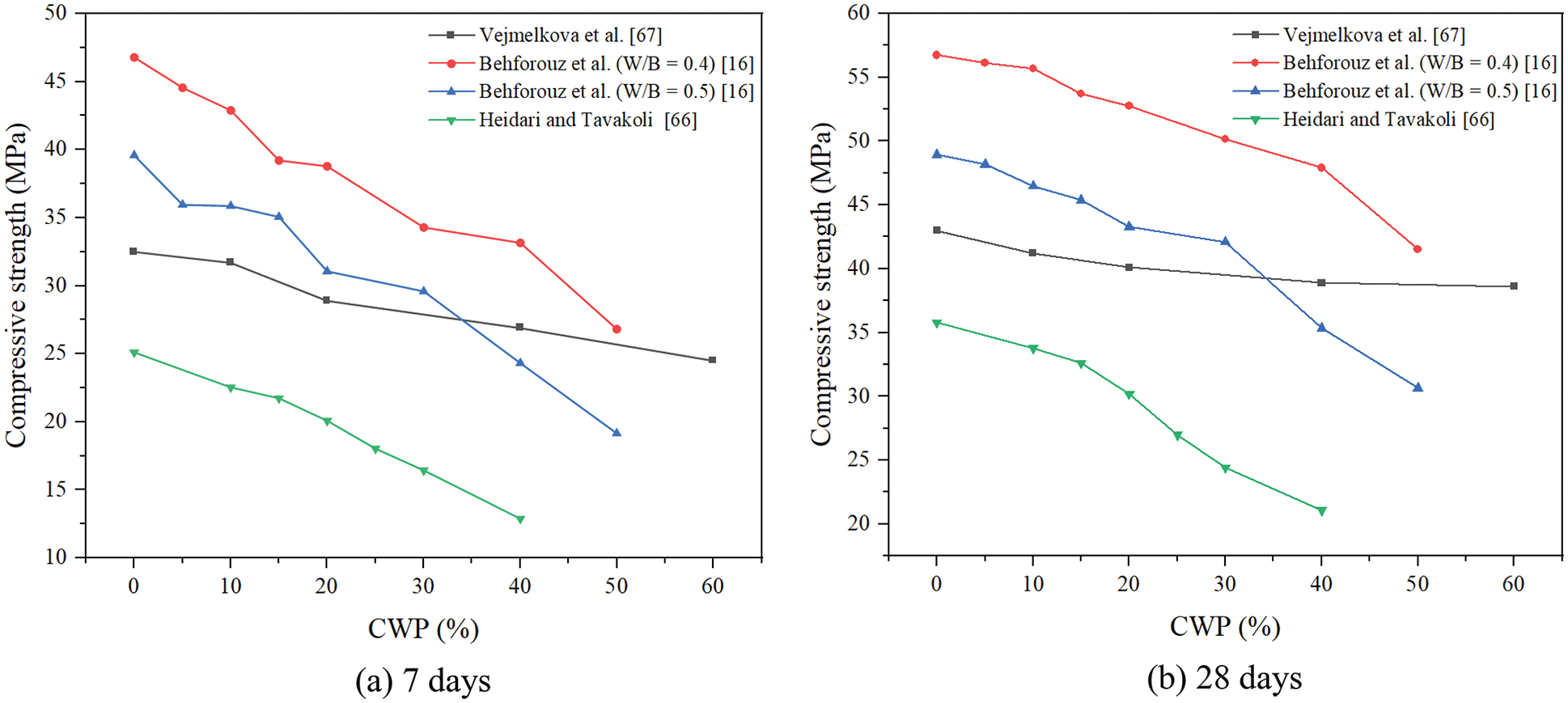
Figure 6: Compressive strength of concrete with various CWP contents. Adapted with permission from reference [16], Copyright © 2020, KISTI, reference [66], Copyright © 2013, Elsevier B.V., and reference [67], Copyright © 2014, Trans Tech Publications Ltd.
Relatively few studies had reported that ceramic waste as a substitute for fine aggregates in concrete caused a drop in the compressive strength of concrete [55]. Alves et al. [26] added bricks as partial fine aggregates to concrete, and it indicated that the compressive strength of concrete could decrease with an increase in the replacement ratio of bricks to fine aggregates. Similar conclusions were obtained by Khatib [69] and Debieb et al. [70]. This may be because bricks, which had a low strength and many pores, slowed the strength development of the cement paste. More research is shown in Fig. 7, where the compressive strength of concrete first increases and then decreases as the content of ceramic waste increased. An increase in the strength of concrete had been reported when fine aggregates were partially replaced with ceramic waste [31,58]. The improvement mechanisms are as follows: (i) Compared with natural sands, rougher ceramic sands can increase the bonding strength with cement pastes, which leads to an increase in mechanical strength [31,71]; (ii) fine ceramic waste aggregates exhibit pozzolanic activity at old ages and promote the production of C-S-H gel [72]; and (iii) because the water absorption of ceramic sands is higher than that of natural sands, ceramic waste is soaked before mixing or additional water is added during mixing. During curing, water is released from the ceramic aggregates, which provides an internal curing effect and contributed to the formation of denser C-S-H gels [73,74].

Figure 7: Compressive strength of concrete containing ceramic waste as fine aggregates [40,62]. Adapted with permission from reference [40], Copyright © 2018, American Society of Civil Engineers, reference [62], Copyright © 2020, IOP Publishing
Figs. 8a–8d show the SEM images of concrete without fine ceramic aggregates and with 40%, 60%, and 100% fine ceramic aggregates, respectively. As shown in Fig. 8a, there was obvious pores in the reference concrete mixture, which led to weak ITZ, poor mechanical strength and impact resistance under drop weight. However, in Figs. 8b–8d, more aggregates were covered by C-S-H gels, and the porosity of ceramic concrete was less than that of ordinary concrete. The formation of a large number of gels by the pozzolanic activity of ceramic aggregates contributed to the reduction in the porosity of concrete and formation of denser structures [74]. This explained why a high strength was achieved with the use of ceramic aggregates. Concrete with 40% fine ceramic aggregates had the highest elastic modulus. It could be seen from Fig. 8b that the ITZ of concrete containing 40% fine ceramic aggregates was smoother and denser. For higher percentages of fine ceramic aggregates (60%, 80%, and 100%), the angularity and roughness of aggregates created pores in concrete samples, reducing elastic modulus. The incorporation of fine ceramic aggregates improved the impact resistance and resistance to chloride penetration of concrete. The pozzolanic behavior of fine ceramic aggregates produced a large amount of hydration products that increased bond area between aggregates and mortar, which increased resistance to falling weight impact and chloride penetration. The addition of fine ceramic aggregates also changed the failure mode from a single large crack to a group of cracks. Cracks moved around aggregates and specimens to propagating through the weakest part. This aggregation of crack movement delayed failure of specimen.
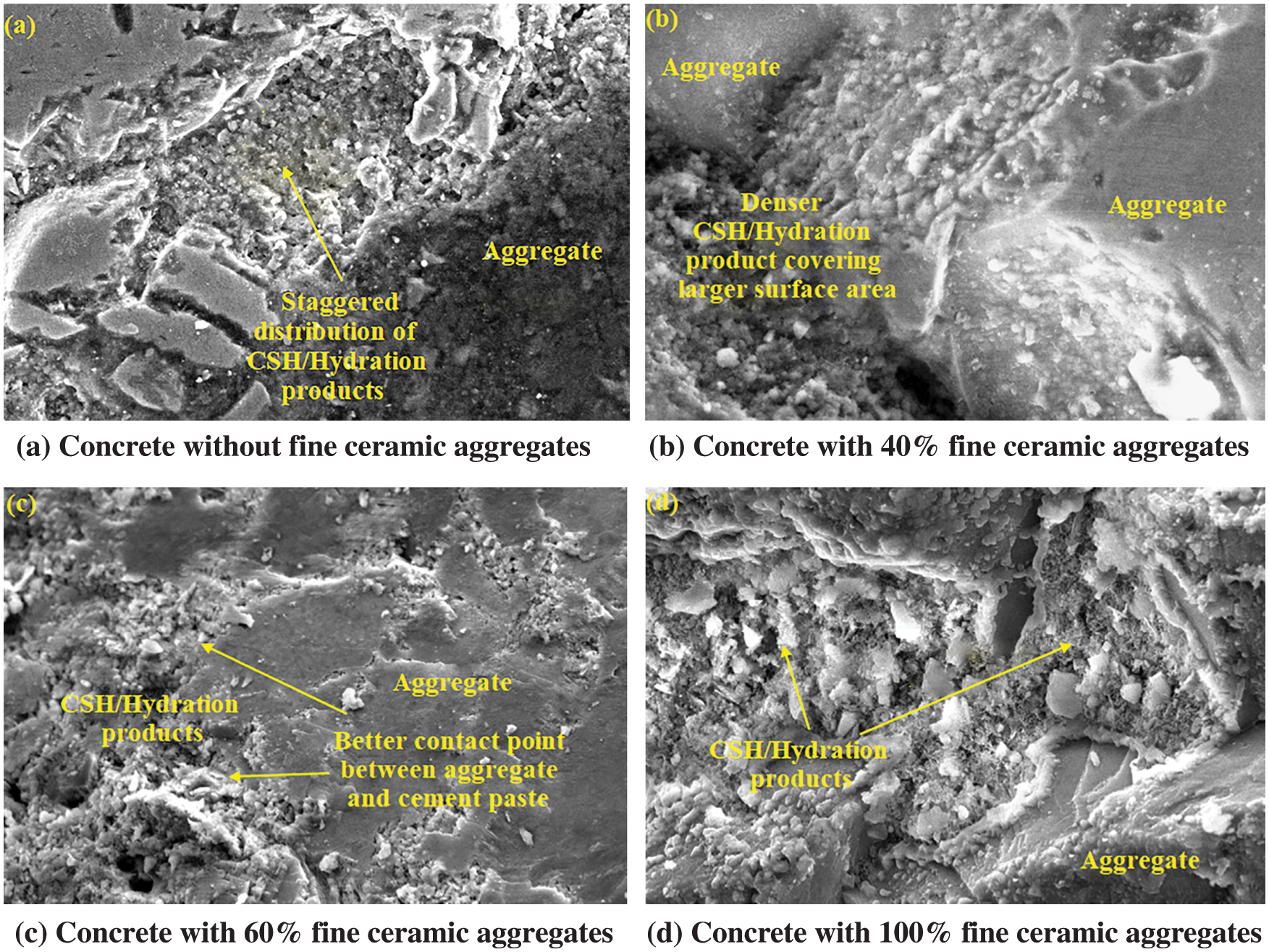
Figure 8: SEM images of concrete with different contents of fine ceramic aggregates [74]. Adapted with permission from reference [74], Copyright © 2018, Elsevier B.V.
It was observed that a 100% replacement of fine aggregates by ceramic waste improved the compressive strength of concrete [20]; however, Torkittikul et al. [10] found that concrete with a 100% substitution level had nearly no slump. Consequently, they suggested that the utilization of moderate fly ash when using fine ceramic waste aggregates could maintain the workability and strength of concrete. In addition, Ogrodnik et al. [19] and Halicka et al. [56] concluded that alumina cement was more conducive to the compressive strength development of sanitary ware aggregate concrete compared to Portland cement. The effects of four methods of replacing natural sand with ceramic waste on concrete strength were studied by Cheng et al. [75]. They reported that the optimal replacement level was different for different replacement methods, and the compressive strength of concrete in which the traditional method was used was greater than that of the reference concrete, regardless of the fine ceramic waste aggregate content.
The compressive strength of concrete with 100% coarse electrical insulator aggregates decreased when the water/binder (W/B) ratio increased, and the decreasing trend with W/B was similar to that of traditional concrete [2]. However, the compressive strength of ceramic electrical insulator concrete was slightly lower than that of traditional concrete for the same W/B ratio [76]. Bakri et al. [77] used ceramic waste (flowerpots, tiles, and bricks) as the coarse aggregates of concrete and found a similar reduction trend in compressive strength. When the replacement level of sanitary ware did not exceed 25%, the compressive strength of concrete containing sanitary ware aggregates was higher than that of the control concrete and improved as the replacement level increased at different ages [21]. This was because more irregular shapes and rougher surfaces provided good bonds for the interface between the cement pastes and sanitary ware aggregates [78]. According to the microstructure, the improvement in the thickness and modulus of elasticity of the interfacial transition zone (ITZ) between pastes and sanitary ware aggregates explained the increase in concrete strength [79]. Almeida et al. [80] found that the 28 d compressive strengths of concrete in which 25%, 50%, 75%, and 100% of the cement had been replaced with sanitary ware coarse aggregates were 3.2%, 7.7%, 5.2%, and 1.4% higher, respectively, than that of the reference concrete. In addition, the use of sanitary ware aggregates did not have a significant impact on the compressive strength of self-consolidating concrete and high-strength concrete [29,81].
Nepomuceno et al. [82] found an increase in compressive strength with curing age when using bricks as coarse aggregates of concrete. A decreasing trend in compressive strength with brick content was also observed. The same conclusion was reached by utilizing fine ceramic brick aggregates in concrete [26,83,84]. Nevertheless, the results that had been obtained using ceramic tiles as partial coarse aggregates in concrete are different. As shown in Fig. 9, Rajprasad et al. [23] reported that the compressive strength of concrete containing coarse ceramic tile aggregates was lower than that of the control concrete and reduced by up to 1.67%. However, Bommisetty et al. [85] found a slight increase in compressive strength when ceramic tile waste partially replaced coarse aggregates. To improve the compressive strength, a method of minimizing the size of coarse ceramic tile aggregates to reduce their smooth surface area and provide a rougher surface was recommended [62]. Xu et al. [25] reported that utilizing coarse ceramic aggregates soaked in a silane coupling agent (KH-550) solution could substantially improve concrete strength. Furthermore, the compressive properties of concrete with unused ceramic tile waste and recycled ceramic tile waste from demolition buildings as coarse aggregates were further investigated (Fig. 10) [86]. The results indicated that the unused ceramic tile aggregates did not significantly slow down the concrete strength development. The compressive strength of concrete containing recycled ceramic tiles was lower than that of concrete with unused ceramic tiles when the replacement level of coarse ceramic aggregates exceeded 75%. The compressive properties of concrete in which different types of ceramic tile waste (porcelain and semi-porcelain, porcelain, and red ceramic) partially replaced coarse aggregates had also been investigated [87,88].

Figure 9: Compressive strengths of concretes containing coarse ceramic tile aggregate. Adapted with permission from reference [23], Copyright © 2020, IOP Publishing
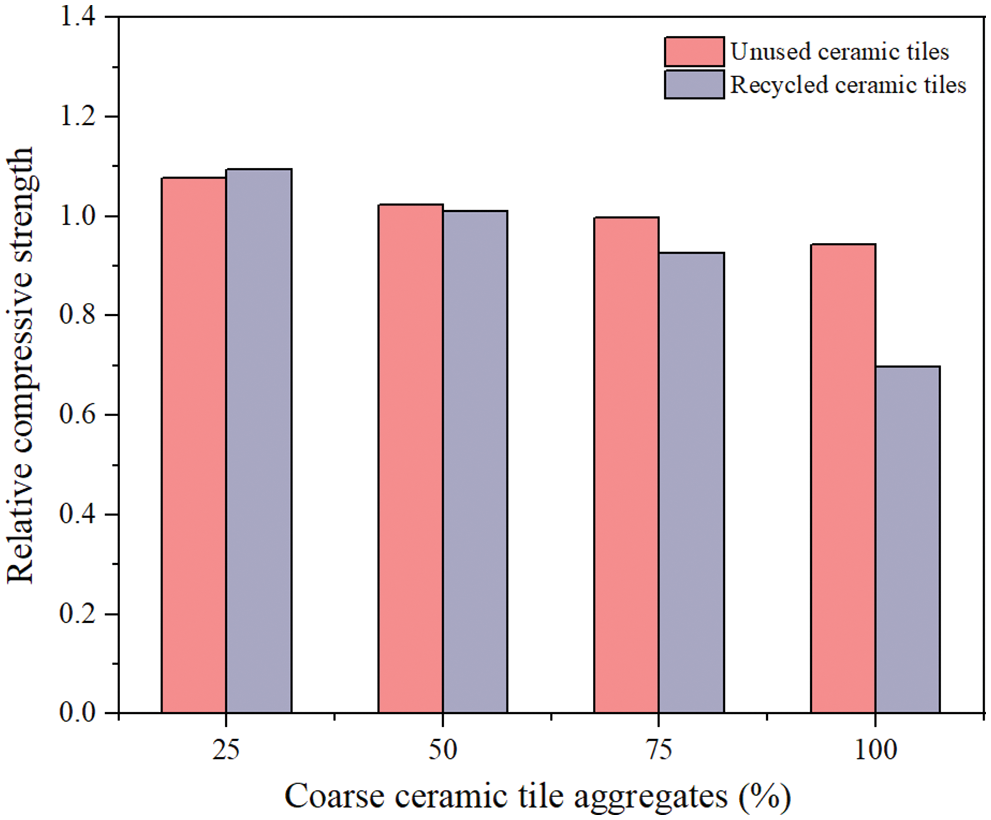
Figure 10: Relative compressive strengths of concretes with coarse ceramic tile aggregate. Adapted with permission from reference [86], Copyright © 2016, Elsevier B.V.
The compressive strength of ceramic aggregate concrete is also affected by fibers and mineral admixtures. The 28-day compressive strength of concrete containing ceramic waste as coarse aggregates decreased with fly ash content. This was because the hydration rate reduced owing to the low activity of fly ash [65]. However, for the same content of fly ash, the addition of silica fume led to an increase in the concrete strength, and the compressive strength of concrete containing fly ash and silica fume was higher than that of the control concrete [87]. The strong pozzolanic effect of silica fume promoted the hydration reaction of cement, and the small-sized particles also played a filling role in concrete. The increase in strength of concrete by silica fume made up for the reduction in strength of concrete by fly ash. The addition of waste carpet fibers at a volume fraction of 1.0% slowed down the compressive strength development of coarse ceramic aggregate concrete, while steel fibers at a volume fraction of up to 1.5% led to an increase in the compressive strength development of coarse ceramic aggregate concrete [27,89]. To study the impact of steel chips and coarse porcelain tile aggregates on the compressive strength of concrete, Keshavarz et al. [90] developed a three-dimensional model of the compressive strength of concrete, as shown in Fig. 11. This model considered both the coarse porcelain tile aggregate replacement ratio and steel chip content.
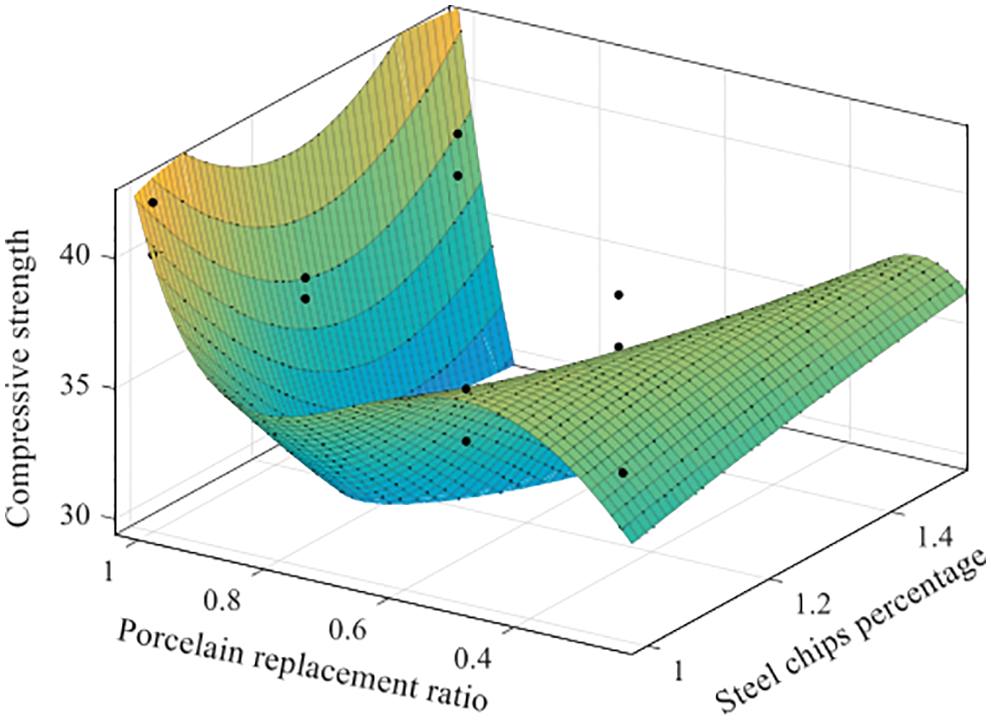
Figure 11: Three-dimensional model for the compressive strength (MPa) of concrete [90]. Adapted with permission from reference [90], Copyright © 2019, Elsevier B.V.
There are two methods for testing the tensile strength of concrete: direct testing and splitting testing. The splitting tensile test is considered the most common method. According to Fig. 12, CWP added to SCC and ordinary Portland (OPC) could result in a decrease in the splitting tensile strength compared to the control sample, and the strength decreased with an increase in the substitution ratio of CWP. However, when ceramic powder and red brick dust were used as substitutes for 5%, 10%, and 15% of the cement and fine aggregates, the splitting tensile strength of concrete mixtures increased by 3.44%, 6.02%, and 4.01%, respectively, compared to the control concrete [91]. Similarly, the positive effect of various levels of CWP on the tensile properties of concrete containing recycled aggregates and ceramic waste as total coarse aggregates was also obtained [46]. Some researchers had studied the effect of CWP on ordinary concrete and self-compacted alkali-activated concrete. In Huseien et al. [53], the use of various contents of CWP as substitutes for ground blast furnace slag in the preparation of self-compacted alkali-activated concrete led to a drop in the splitting tensile strength of concrete, and the splitting tensile strength decreased when the CWP content increased. The results were attributed to a decrease in CaO content with an increase in CWP content, which caused a reduction in the rate of C-S-H gel production. In addition, as shown in Fig. 13, an exponential relationship between the compressive strength and splitting tensile strength was obtained, and the correlation coefficient was greater than 0.9, which indicated that the splitting tensile strength was also related to the compressive strength of self-compacted alkali-activated concrete with ceramic powder.
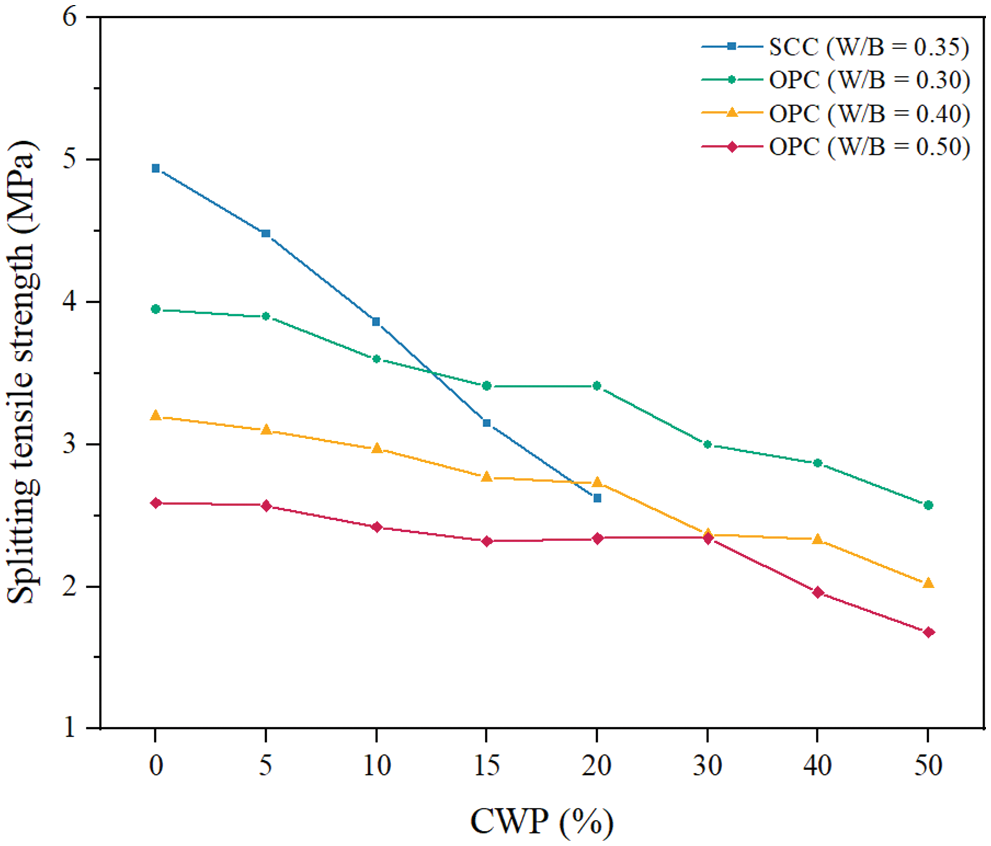
Figure 12: Splitting tensile strength of concrete with CWP at 28 d. Adapted with permission from reference [16], Copyright © 2020, KISTI., and reference [51], Copyright © 2017, Elsevier B.V.
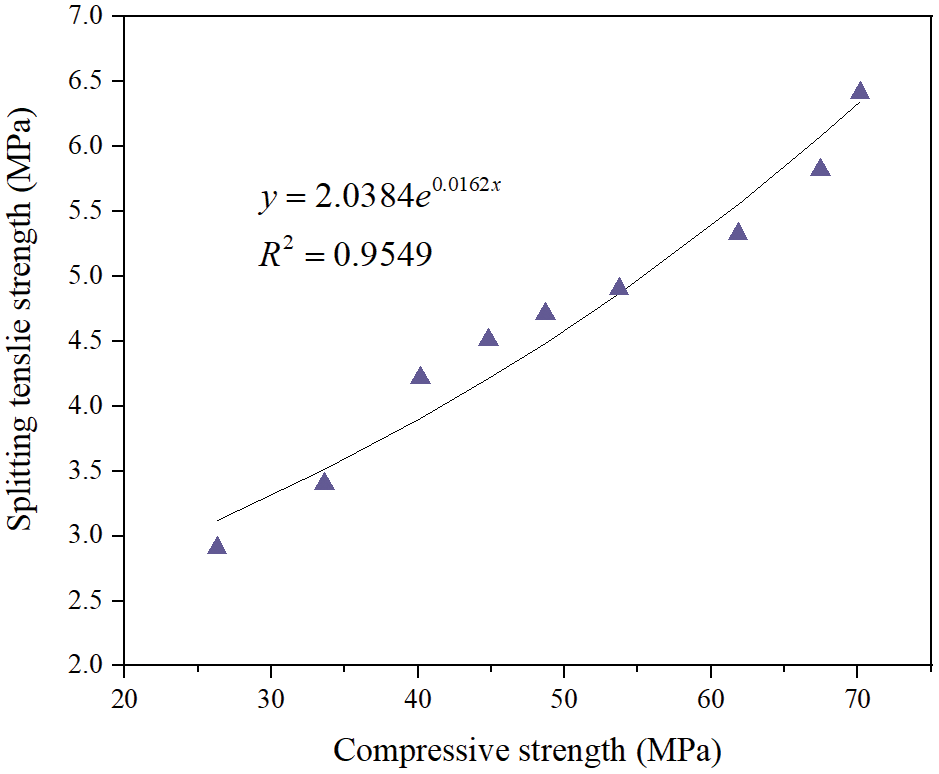
Figure 13: Relationship between the compressive strength and splitting tensile strength. Adapted with permission from reference [53], Copyright © 2020, Elsevier B.V.
The performances of ceramic aggregates are not separated from those of natural aggregates, so they can be used in concrete as aggregate substitutes. The splitting tensile strengths of concrete containing 20%, 50% and 100% brick waste acting as a substitute for fine aggregates were 2.2%, 5.7% and 5.2% lower than that of reference concrete in Alves et al. [26]. This may be because the porosity of the paste increased when the content of fine ceramic waste aggregates increased. Moreover, because the effective W/B ratio increased with the replacement level, the strength of concrete containing fine sanitary ware aggregates was lower than that of concrete containing fine brick aggregates. However, according to Siddique et al. [74], the splitting tensile strength of fine ceramic aggregate concrete with various W/B ratios (0.35, 0.45, and 0.55) was higher than that of concrete without fine ceramic aggregates. As shown in Fig. 14, compared to that of the reference specimen, the compressive strength of concrete mixes containing bone china as fine aggregates increased significantly. However, when the W/B ratio was different, the substitution rate corresponding to the maximum tensile strength also differed. Similarly, the splitting tensile strength of later age increased compared to that of the control concrete when ceramic wall tile waste was used to replace 25%–100% of the fine aggregates despite a decrease in splitting tensile strength of early age being observed [92]. Some studies suggested that fine ceramic waste aggregates, with a rough texture and slight pozzolanic activity, helped to form a good cement paste–aggregate interface [31,72]. In addition, fine ceramic waste aggregates improved the residual mechanical properties of concrete after exposure to high temperatures, especially the splitting tensile strength [31]. This conclusion was supported by Halicka et al. [56].
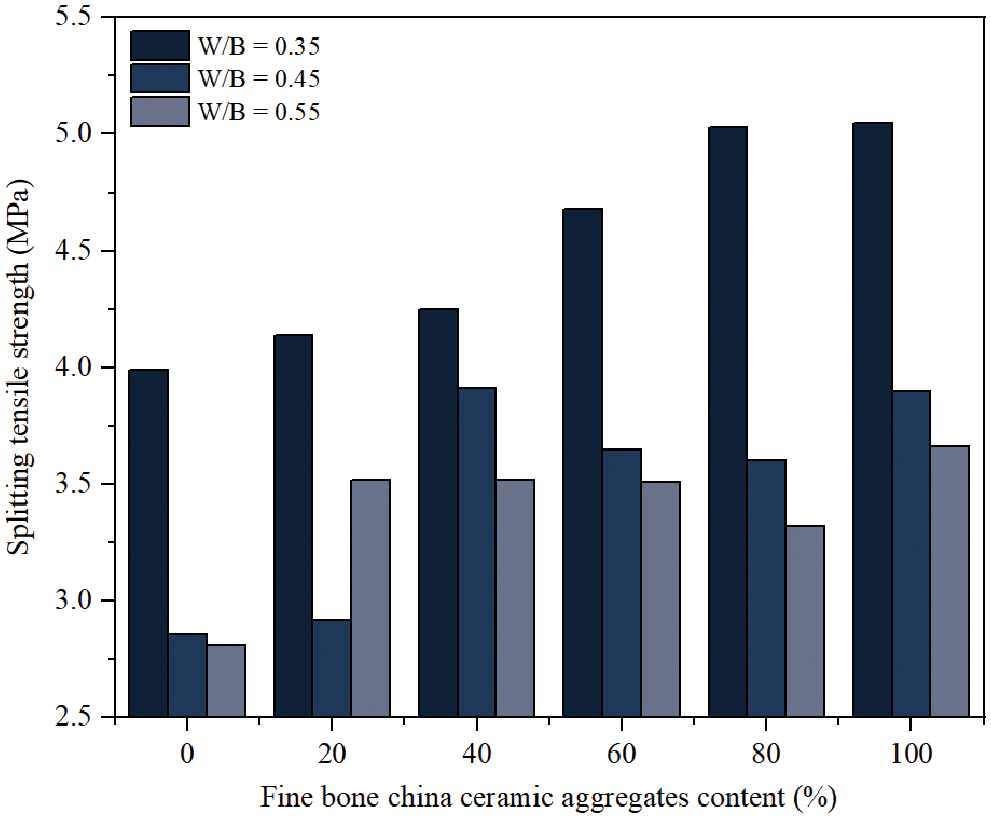
Figure 14: Splitting tensile strength of concrete containing fine bone china ceramic. Adapted with permission from reference [74], Copyright © 2018, Elsevier B.V.
As expected, the use of ceramic electrical insulator industrial waste as coarse aggregates in concrete could slow down the splitting tensile strength of concrete [2]. Similarly, the addition of coarse ceramic brick aggregates slowed down the tensile strength development of concrete, which gradually decreased as the replacement ratio increases [82]. Using coarse porous ceramic aggregates in concrete also resulted in a reduction in the splitting tensile strength at early and later ages. The higher the content of coarse porous ceramic aggregates, the greater the decrease in the splitting tensile strength [93]. However, the strength of concrete containing ceramic sanitary wares and tiles was different. Garcia-Gonzalez et al. [18] reported that the splitting tensile strength of the reference sample was the same as that of concrete containing sanitary ware waste as coarse aggregates (95% confidence). Moreover, other studies reported that, when sanitary ware waste replaced a small percentage of coarse aggregates, the splitting tensile strength of concrete could be higher than that of the reference concrete. The addition of ceramic tile waste also increased the tensile strength of concrete, as shown in Figs. 15 and 16 [21,85,92,94]. There were two reasons for the increase in concrete strength: (i) The inherent performance of ceramic aggregates led to good bonding; and (ii) ceramic aggregates that could be used to refine pores increased the volume of capillary pores and reduced the volume of macropores.

Figure 15: Splitting tensile strength of concrete with sanitary ware waste. Adapted with permission from reference [94], Copyright © 2012, Elsevier B.V.
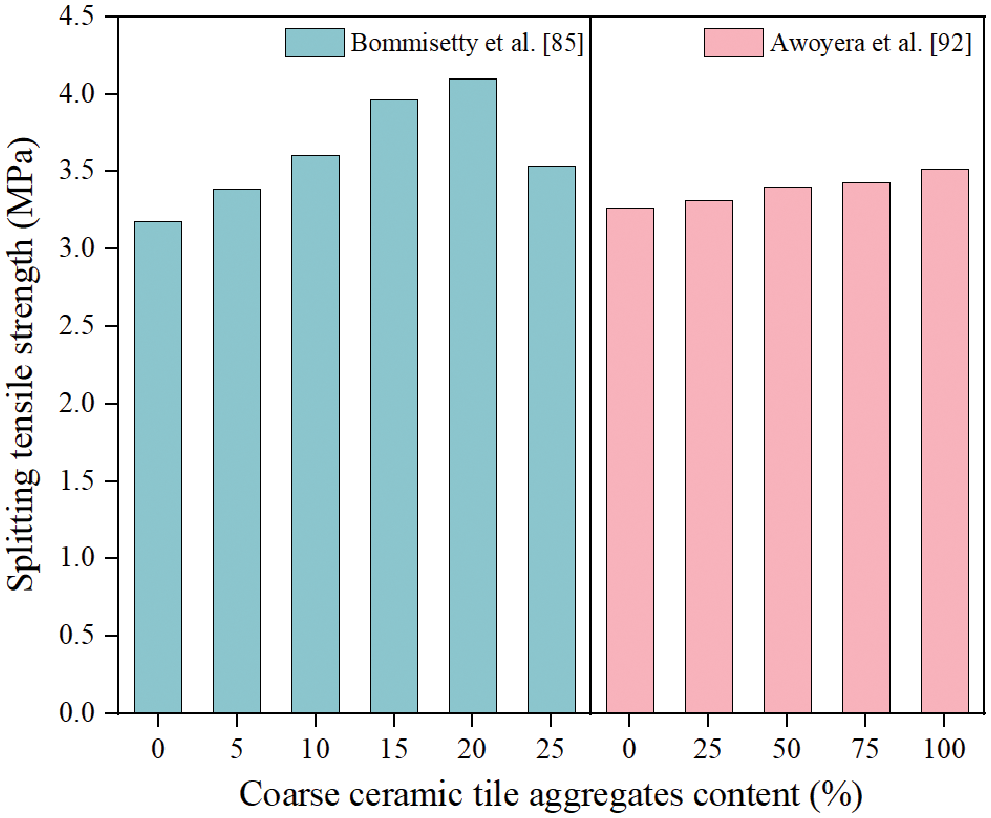
Figure 16: Splitting tensile strength of concrete with ceramic tiles. Adapted with permission from reference [85], Copyright © 2019, Elsevier B.V., and reference [92], Copyright © 2018, Informa UK Limited
Nevertheless, in Wu’s study, coarse semi-porcelain tile aggregates may have slightly slowed down the tensile strength development of HPC, while coarse porcelain tile aggregates did not have a negative effect on the tensile strength of HPC [87]. A 100% substitution of coarse aggregates with ceramic tiles was not recommended because of the decrease in the tensile strength of concrete caused by using ceramic tiles as the only coarse aggregates [86]. As shown in Fig. 17 (where P is porcelain aggregate concrete, B is semi-porcelain aggregate concrete, F is fly ash, S is silica fume, and the numbers represent the content percentages), the addition of fly ash to concrete with ceramic tiles as the only coarse aggregates improved the tensile strength, and the influence of silica fume content on the tensile strength of coarse semi-porcelain aggregate concrete was greater than that of coarse porcelain aggregate concrete [65]. In addition, the use of both ceramic waste and other waste (laterite aggregates, recycled aggregates, and limestone powders) in concrete had also been studied, and the optimum mix proportion was obtained [46,95,96].
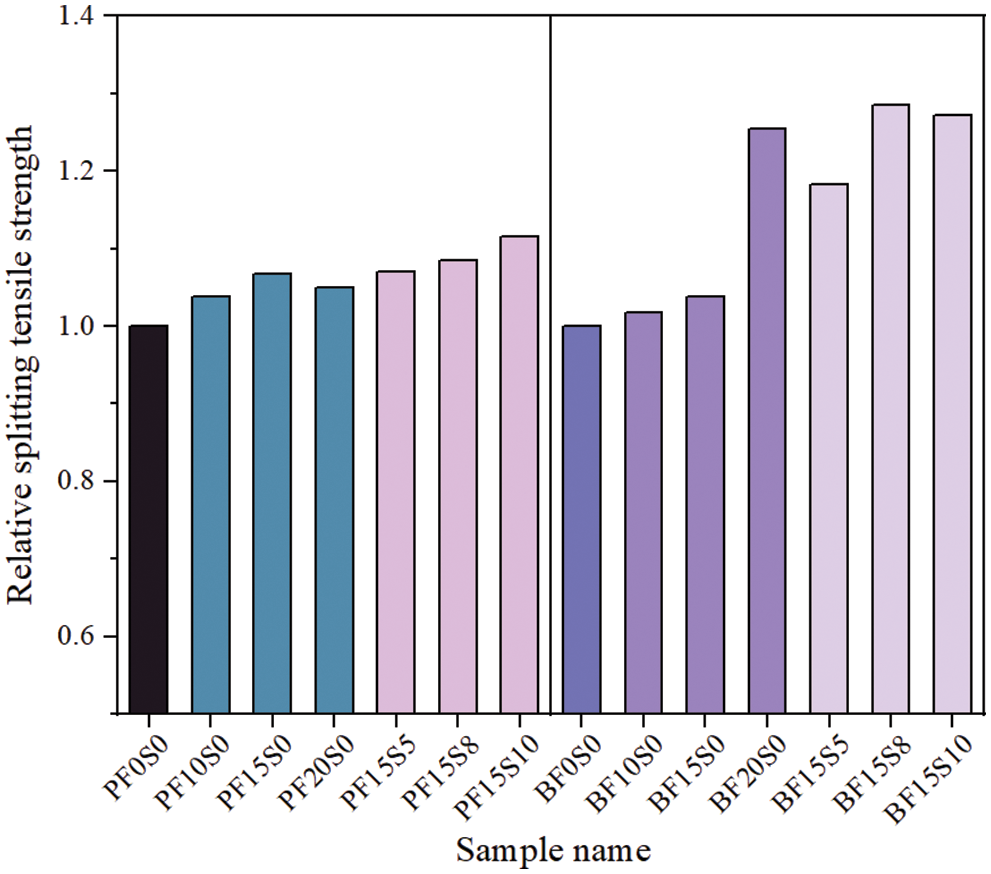
Figure 17: Relative splitting tensile strength of ceramic aggregate concrete containing fly ash and silica fume. Adapted with permission from reference [65], China Academic Journal Electronic Publishing House
Utilizing fibers to increase the strength of concrete is a common method. Steel fibers could improve the tensile strength of concrete, and the splitting tensile strength of ceramic aggregate concrete usually increased with steel fiber content (volume fraction no more than 1.5%) [89,99]. Keshavarz et al. [90] investigated the impact of both coarse ceramic aggregates and steel chip content on the tensile strength of concrete, and found that the tensile properties of concrete containing 50% coarse ceramic aggregates and 1% steel chips performed the best in their study. Moreover, the bridging effect of carpet fibers was responsible for the significant improvement in the tensile properties of concrete containing carpet fibers and ceramic aggregates [27]. A support vector machine (SVM) and gradient boosting machine (GBM) were used to develop prediction models for predicting the strength of concrete containing coarse ceramic aggregates and nylon fibers [100]. The study demonstrated that the performance of the GBM model in predicting the tensile strength of concrete was better than that of the SVM model.
The empirical equations for the compressive and tensile strengths of ceramic concrete are summarized in Table 2, where

Flexural strength is the ability of a concrete beam to withstand bending and destruction. Similar to the flexural strength development of OPC, the flexural strength of concrete containing CWP increased gradually with the extension of curing ages and decreased with an increase in W/B. Atkuri et al. [68] believed that the addition of CWP slowed the flexural strength of concrete and investigated the effect of CWP size on flexural performance. The results indicated that when W/B was 0.4, the 28-d flexural strength of concrete containing CWP with a size less than 90 µm was higher than that of concrete containing CWP with sizes ranging from 90 to 150 µm despite the CWP substitution ratio for cement. The conclusion that CWP could lead to a decrease in flexural strength was also demonstrated by the experiments of Vejmelkova et al. [101], who reported that concrete containing up to 20% CWP exhibited lower flexural strength than the control specimen. The flexural strength of concrete with 20% CWP was lower than that of concrete with 15% CWP, but it was still acceptable. When CWP partially replaced cement, the impact of red bricks or other ceramic waste dust as partial fine aggregates on the flexural strength of concrete had been studied [91,102]. The test results revealed that the flexural strength of concrete with brick dust was higher than that of the control specimen; however, an opposite result was obtained for concrete containing other types of ceramic waste. If CTWP was added to UHPC as a cement replacement, the flexural strength at 3 d would reduce and the flexural strength at 7 days would increase and then decrease [48]. This may be due to the reaction between CTWP and CH, which did not occur at early ages. The flexural load–deformation curves of UHPC with various levels of CTWP were presented in Fig. 18. All of the curves were similar, except for the curves of UHPC containing 55% CTWP, which suggested that CTWP did not change the fracture behavior of concrete at yielding.

Figure 18: Flexural load–deformation curves of UHPC with various level of CTWP. Adapted with permission from reference [48], Copyright © 2021, Elsevier B.V.
Ceramic tile waste had been used as a substitute for fine aggregates in concrete, and its effect on the flexural strength of concrete in different studies was not the same. Johnson Daniel et al. [55] used ceramic tiles as substitutes for 5%, 10%, 15%, and 20% of the fine aggregates in concrete and found that the 7 d flexural strength of concrete containing ceramic tiles was higher than that of the control concrete, except for the concrete in which 20% of the fine aggregate was replaced with ceramic tiles; however, the 28 d strength of concrete containing ceramic tiles was lower than that of the control concrete despite the replacement ratio. According to Yahya et al. [59], ceramic tiles were collected from construction site areas. The study revealed that the development of concrete strength was similar at each curing age, and flexural strength first increased and then decreased as the substitution level of fine ceramic tile aggregates increased. This was because ceramic tiles with smooth surfaces at the top and bottom caused low cohesion between the cement pastes and fine ceramic tile aggregates. Moreover, as the replacement ratio of fine ceramic waste aggregates increased, the flexural strength gradually declined when crushed bricks and sanitary wares were used as partial replacements for sand [70,103]. However, the results obtained when fine bone china ceramic aggregates were added to concrete were opposite. In a study by Siddique et al. [74], when the W/B ratio was 0.35, the flexural strength of concrete mix containing 20%, 40%, 60%, 80%, and 100% fine bone China ceramic aggregates slightly increased by 1.17%, 1.23%, 1.28%, 1.33%, and 1.30%, respectively, compared to the reference concrete. The strength of concrete containing 80% bone china ceramic waste was the highest despite the W/B ratio. Studies indicated that a higher silica content and percentage of fine size in bone china ceramic waste helped to improve the mechanical strength of the concrete [104]. In addition, the effect of various ceramic wastes on the strength of concrete was investigated. As shown in Fig. 19, when red ceramic, glazed ceramic, sanitary ceramic, basalt, and gravel were used as the aggregates in concrete, the flexural strength of concrete with sanitary ceramic was the highest and that of concrete with red ceramic was the lowest among the five groups [105]. The high content of dust in red ceramic aggregates may be the reason for the low flexural strength of concrete. The dust can wrap aggregate particles and then further prevented pastes from contacting aggregates, resulting in weakening of ITZ. Certainly, ceramic tiles and sanitary wares could replace sand in the preparation of SCC, and the flexural strength of SCC containing these fine ceramic waste aggregates was found to be greater than that of the reference SCC. This was due to the higher hardness of ceramic waste grains than sand [61] and denser ITZ between ceramic aggregates and cement pastes than that between sand and cement pastes [106]. Furthermore, the strength of sanitary ware concrete was higher than that of ceramic tile concrete when the substitution ratio of ceramic waste was less than 60%, which was different from the compressive strength results [61].

Figure 19: Flexural strengths of concrete containing different aggregates. Adapted with permission from reference [105], Copyright © 2018, MDPI
Certainly, because the inherent characteristics of different types of ceramic waste are slightly different, it is necessary to study the flexural strength of concrete with different ceramic aggregates. Ceramic electrical insulator waste was considered to be a substitute for natural coarse aggregates in concrete [2]. As shown in Fig. 20, the variation in the flexural strength of electrical insulator concrete with different W/B ratios was similar to that of conventional concrete, and the ceramic concrete exhibited a slightly lower strength in contrast with conventional concrete for the same W/B ratio. In addition, a linear reduction trend of flexural strength with an increase in coarse ceramic brick aggregates had been reported [82]. If the gravel was replaced with ceramic bricks in structural concrete, the replacement ratio should not exceed 30%. However, different researchers reported different effects of ceramic tile aggregates on the flexural strength of concrete. The addition of ceramic tile aggregates may slightly increase the flexural strength of concrete, according to Zareei et al. [27] and Bommisetty et al. [85] (Fig. 21a); however, ceramic tile aggregates had a negative impact on the strength of concrete and a higher ceramic tile content corresponded to a lower flexural strength according to Rajprasad et al. [23] and Mohammed et al. [107] (Fig. 21b). This increase may be attributed to the less smooth area of the ceramic tile aggregates utilized in these studies, which had been processed in advance, as smooth surfaces slowed down the bonding between cement pastes and ceramic aggregates [86]. Ceramic aggregates from construction and demolition waste, which contained many impurities (mortar, concrete, and sawdust), were present in non-structural concrete (curbstones and paving blocks) [108,109].

Figure 20: Flexural strength of ceramic electrical insulator concrete with different W/B ratios. Adapted with permission from reference [2], Copyright © 2005, Elsevier B.V.
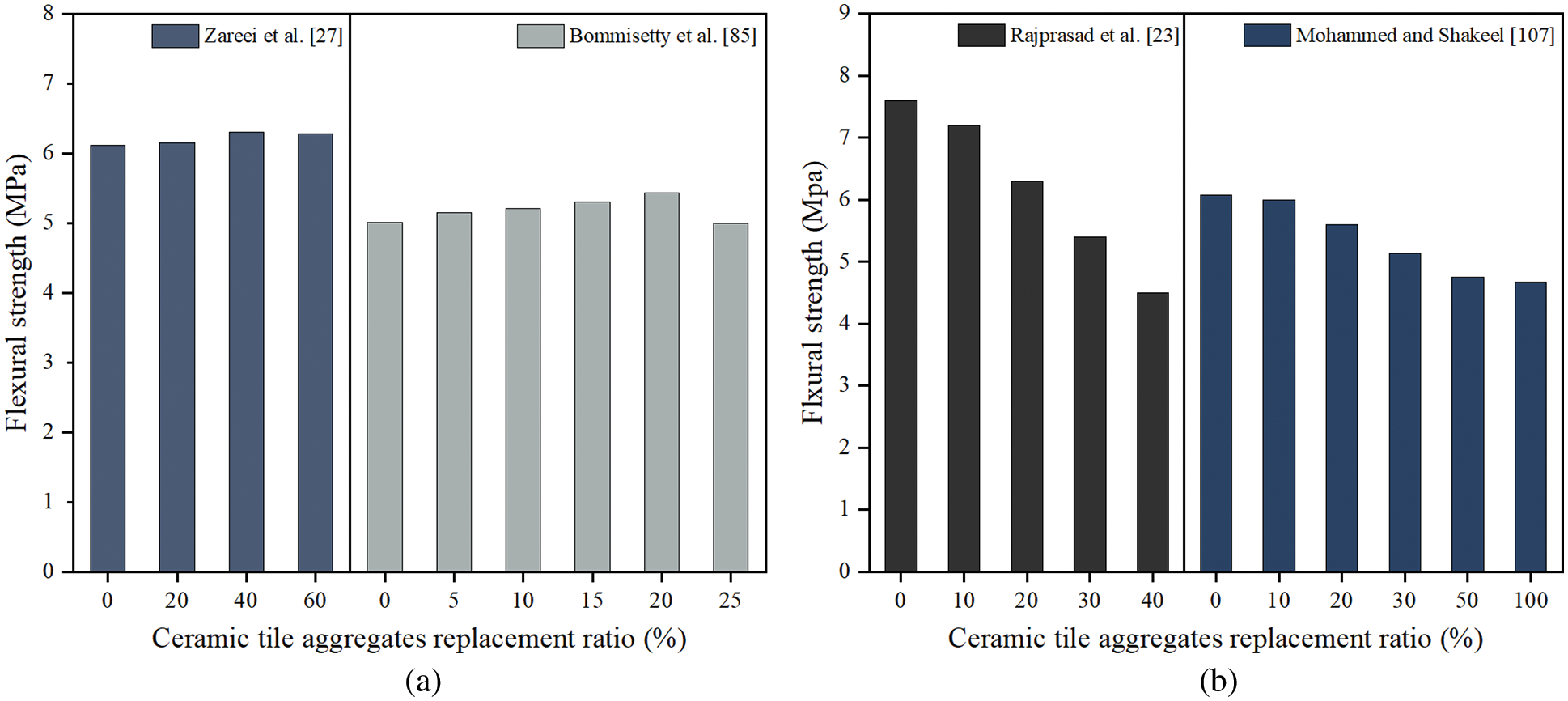
Figure 21: Flexural strength of concrete with different replacement ratios of ceramic tiles. Adapted with permission from reference [23], Copyright © 2020, IOP Publishing, reference [27], Copyright © 2019, Elsevier B.V., reference [85], Copyright © 2019, Elsevier B.V., and reference [107], Copyright © 2020, Springer Nature Switzerland AG
Fibers are an important factor affecting the mechanical performance of concrete. For concrete containing ceramic waste as coarse aggregates, the flexural strength increased when the steel fiber content increased [89,99]. However, an increase in the steel fibers did not always improve the flexural strength of concrete. The incorporation of steel chips and coarse porcelain ceramic aggregates significantly improved the flexural strength, as they increased the tensile strength and reduced the ratio of crack development during loading [90]. The flexural strength of concrete can be estimated from the compressive strength according to the equations in some specific national codes. Zareei et al. [27] compared the mechanical properties of high-strength concrete containing different replacement ratios of coarse ceramic aggregates and carpet fiber content obtained by using the code equations based on the compressive strength of concrete with those obtained from experiments (Fig. 22). The results indicated that flexural strength was slightly underestimated by ACI 318 [110] and CSA A23.3-04 [111] and overestimated by EC-04 [112]. There was an error between the forecasting results generated by the code equations and the actual results. Therefore, more appropriate equations need to be developed.
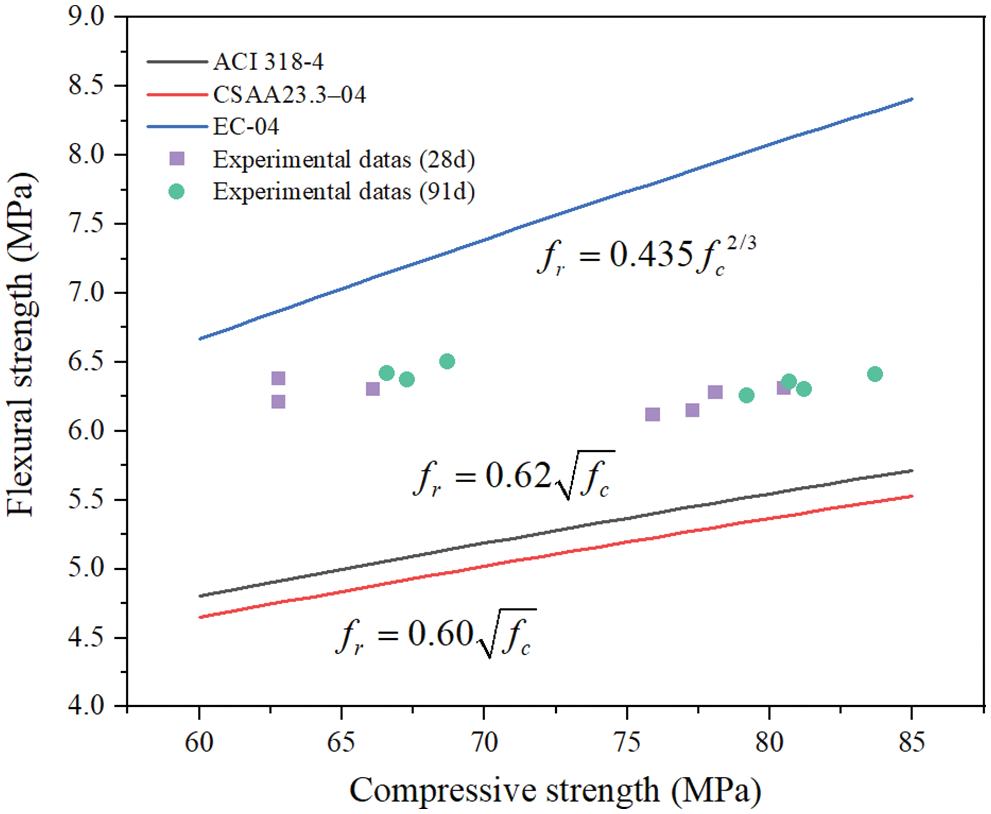
Figure 22: Relationship between the flexural strength (
The elastic modulus represents the ability of concrete to resist elastic deformation. The higher the elastic modulus, the harder the material. It was observed that substituting partial cement in concrete with CWP (10%, 20%, and 40%) did not have an adverse effect on the elastic modulus of the concrete [113]. However, a decrease in the elastic modulus of concrete containing ceramic tile powder was observed. Furthermore, when the replacement ratio was 30%, the elastic modulus was 21.875% lower than that of the reference concrete in another study [102]. Shen et al. [114] further studied the mechanical properties of ceramic aggregate concrete with ceramic powders and found that the elastic modulus of concrete containing ceramic powder (no more than 30%) was higher than that of concrete without ceramic powder. This was attributed to the micro-filler effect of the ceramic powder, resulting in a denser structure of concrete.
In general, replacing natural aggregates with ceramic waste reduced the elastic modulus of concrete. As shown in Fig. 23, if bricks, ceramic tiles, and sanitary wares were used as substitutes for fine or coarse aggregates, the elastic modulus of concrete would reduce, and a higher reduction corresponded to a higher replacement ratio. Moreover, the results were similar when bricks and sanitary wares were used as substitutes for fine and coarse aggregates, respectively. It is well known that the elastic modulus of concrete is closely related to the coarse aggregate stiffness, mortar paste stiffness, porosity of the concrete, and bonding between pastes and aggregates [74]. Therefore, the reduction in elastic modulus can be attributed to the following four reasons: (i) The stiffness of coarse ceramic aggregates is lower than that of natural aggregates; (ii) fine ceramic aggregates with lower stiffness lead to lower stiffness of the mortar pastes; (iii) the angular shapes of the aggregates create pores in the concrete; and (iv) the smooth surface of the ceramic aggregates weakens the bonding between itself and the paste. Nevertheless, in Fig. 23, there was a case where the elastic modulus of concrete with coarse ceramic tile aggregates was slightly higher or substantially higher than that of the reference concrete. These results could be attributed to the reduced angularity of the aggregates due to the use of thicker ceramic tiles. It was observed that a lower angularity was consistent with a higher elastic modulus. Furthermore, bone china ceramic aggregate concrete had an excellent elastic modulus as the fine bone china ceramic aggregates increased the stiffness of mortar pastes. With regard to the elastic modulus, ceramic tiles and sanitary wares had been utilized in SCC as an alternative to partial sands [61].
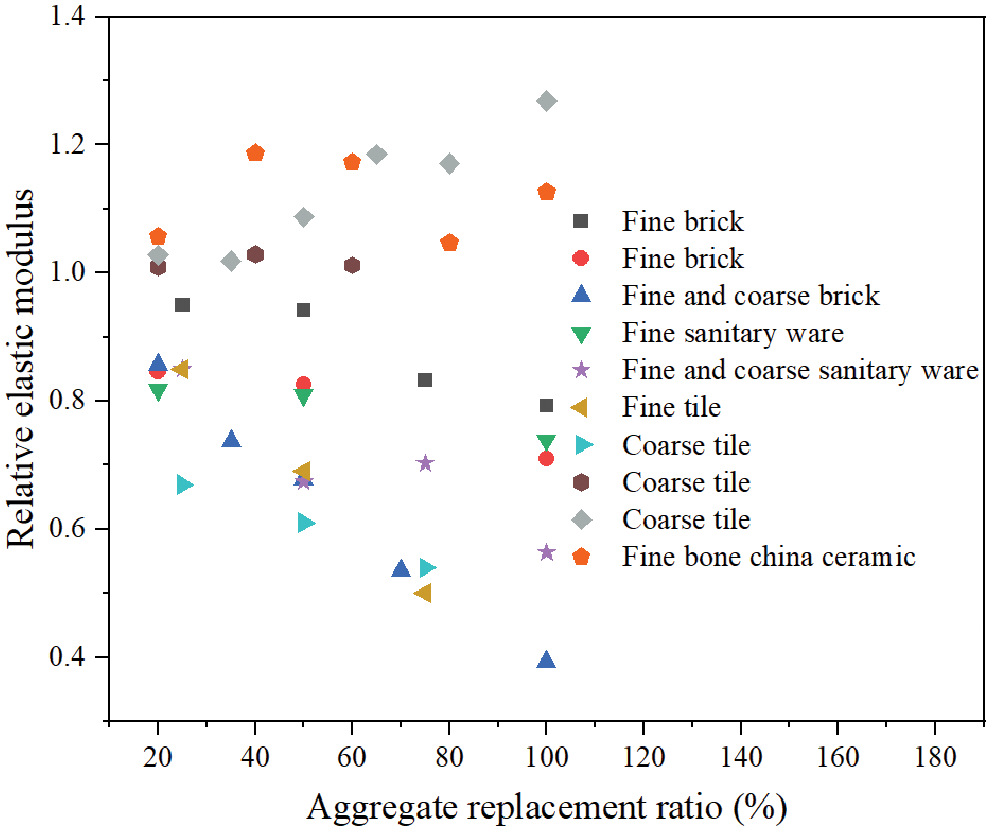
Figure 23: Relative elastic moduli of concrete with different ceramic aggregate contents [26,27,58,64,69,74,84,86]. Adapted with permission from reference [26], Copyright © 2014, Elsevier B.V., reference [27], Copyright © 2019, Elsevier B.V., reference [64], Copyright © 2012, Springer, reference [69], Copyright © 2005, Elsevier B.V., reference [74], Copyright © 2018, Elsevier B.V., reference [84], Copyright © 2017, Elsevier B.V., and reference [86], Copyright © 2016, Elsevier B.V.
Fiber is a factor affecting the elastic modulus of ceramic aggregate concrete. The available research suggested that steel fibers increased the elastic modulus of concrete with coarse ceramic aggregates [99]. However, 1% carpet fibers negatively affected the elastic modulus of ceramic aggregate concrete [27]. In addition, the elastic modulus of concrete containing coarse ceramic aggregates soaked in KH-550 solution increased, as KH-550 improved the surface performance of ceramic aggregates, increasing the bonding between aggregates and pastes [25].
5 Durability of Concrete with Ceramic Waste
Water absorption is closely related to the porosity of concrete, which determines the durability of concrete. It was observed that when brick powder replaces cement, a replacement ratio of less than 15% improved the vacuum water absorption of concrete, and a replacement ratio above 15% led to an increase in porosity, which could result in increased vacuum water absorption [15]. Similarly, in a separate study, the vacuum water absorption of concrete with 20% brick powder was 5% higher than that of the reference concrete [20]. Fig. 24 presents the water absorption of concrete containing different sanitary ware powder and ceramic tile powder contents. The addition of sanitary ware powder and ceramic tile powder contributed to a reduction in water absorption, and water absorption was the lowest at a replacement percentage of ceramic tile powder of 20%. This was attributed to the pozzolanic reaction between ceramic powders and Ca(OH)2, which produced more C-S-H gels. This resulted in a denser matrix [66]. Li et al. [115] showed that ceramic powders significantly refined pore structure of concrete to reduce water absorption. At the same time, concrete containing ceramic powders may had excellent durability related to transportation. More ceramic powders led to less hydration products, looser matrix and more pores. Therefore, the water absorption of concrete gradually increased. In terms of mechanical properties, this represented decline in compressive, tensile and flexural strength. There was a negative correlation between mechanical strength and water absorption. Interestingly, ceramic powders, which were rich in silicon and aluminum in geopolymer concrete, were studied. The study found that, with an increase in ceramic powders, C-S-H gel formation decreased, and the looseness of the C-S-H gels increased. This caused a reduction in the water absorption. An alkali solution with a high molar concentration typically exhibited a low water absorption [53,116]. Moreover, mineral admixtures (fly ash, silica fume, and metakaolin) could improve the durability of ceramic powder concrete. Nano-SiO2 utilized in ceramic powder concrete further reduced water absorption due to its filling effect and pozzolanic reaction, causing an increase in the density and compressive strength of concrete [66]. Karthikeyan et al. [117] reported similar results. The reduction effect of metakaolin on water absorption resembled that of nano-SiO2.
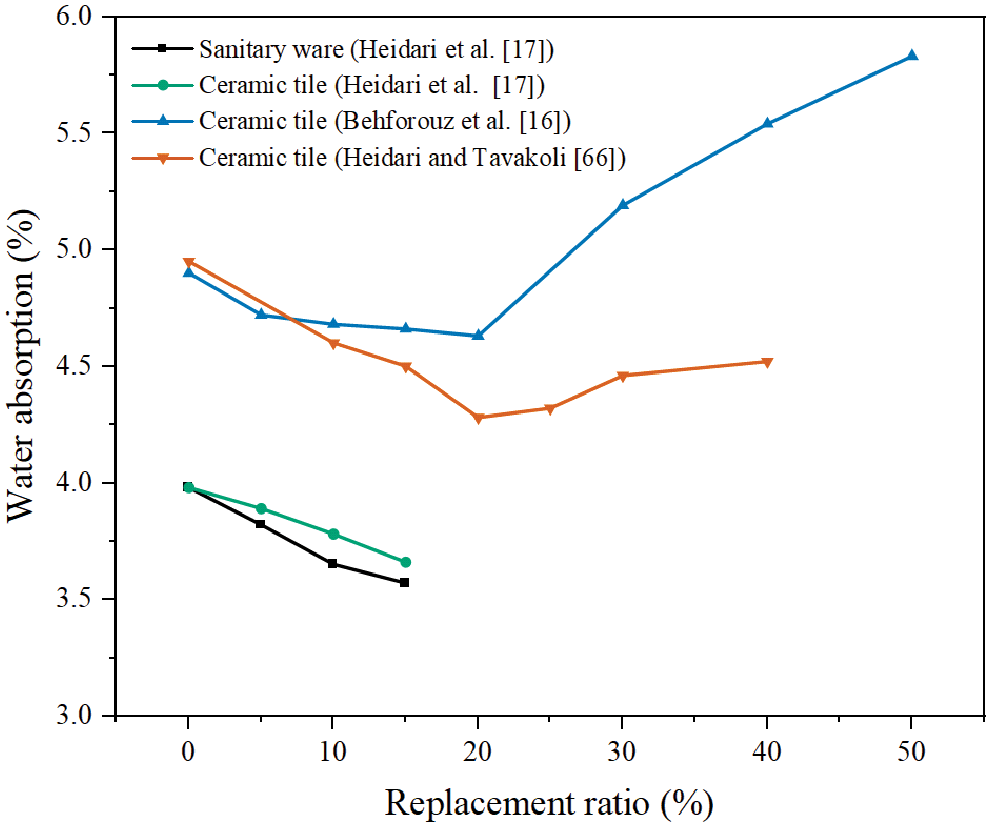
Figure 24: Water absorption of concrete with ceramic powder at 90 days. Adapted with permission from reference [16], Copyright © 2020, KISTI., reference [17], Copyright © 2019, UTHM Publisher
Typically, if ceramics are used as substitutes for fine aggregate, the water absorption of concrete increased. This was mainly due to the high water absorption of the ceramic aggregates. Fine ceramic tiles, bricks, and bone china ceramic aggregates used in concrete significantly increased water absorption [20,59,70,72]. Siddique et al. [72] found that the capillaries formed by higher bleeding in fine ceramic aggregate concrete and pores formed by the release of water into the fine aggregates resulted in an increase in porosity and water absorption. Guendouz et al. [61] tested the capillary water absorption of flowable sand concrete in which ceramic tiles and sanitary ware replaced 10%, 20%, 30%, 40%, 50%, and 60% of the sand (by volume), respectively. The results revealed that the capillary water absorption increased with fine ceramic aggregate content and at the same replacement ratio. Moreover, the water absorption of concrete incorporating ceramic tiles was lower than that of sanitary-ware concrete. This was because the water absorption and porosity of the sanitary ware were higher than those of the ceramic tile.
An increase in water absorption was found in ordinary concrete or high-strength concrete when utilizing ceramic tiles or sanitary wares as coarse aggregates [29,78,90]. Surprisingly, although the water absorption of porcelain tiles was lower than that of natural coarse aggregates, the water absorption of ceramic concrete was close to that of the reference concrete only when the replacement ratio was 25%, and the water absorption increased significantly when the replacement ratio was higher [88]. The linear correlation between water absorption and porosity vs. the replacement ratio of coarse ceramic aggregates is shown in Fig. 25. The values of the two correlation coefficients were greater than 0.9, showing a good correlation between them. Therefore, these two formulas could inform the study of the porosity and water absorption of recycled aggregate concrete. There was no doubt that the addition of coarse electrical insulator aggregates could improve concrete water absorption. A higher W/B corresponded to higher water absorption [76]. Normally, the water absorption of concrete in which coarse and fine aggregates had been replaced with ceramic waste was greater than that of the reference sample. Nevertheless, Ulewicz et al. [54] drew completely opposite conclusions, and water absorption decreased with ceramic waste content. Furthermore, the effect of carpet fibers on the durability of ceramic aggregate concrete was studied. The addition of carpet fibers to concrete with coarse ceramic aggregates could further improve water absorption by increasing the number of pores for the balling effect of the fibers [27]. To slow down water absorption and improve the durability of ceramic aggregate concrete, the use of mineral admixtures is also an effective method.
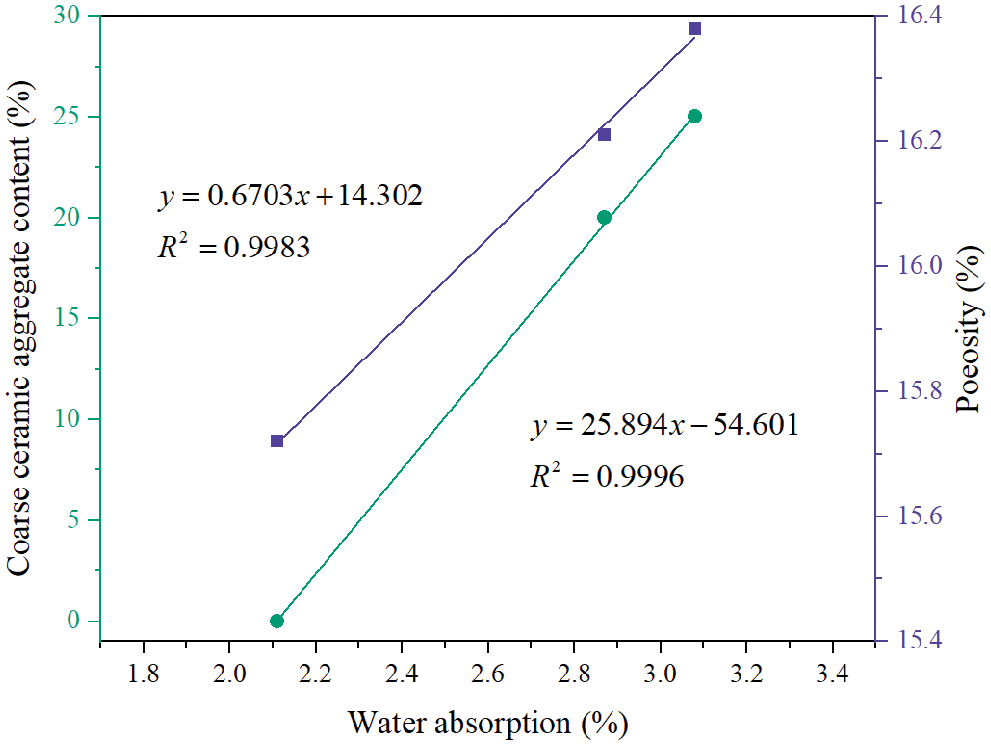
Figure 25: Correlation between water absorption and porosity vs. the replacement ratio of coarse ceramic aggregates. Adapted with permission from reference [78], Copyright © 2013, Elsevier B.V.
5.2 Resistance to Chloride Penetration
Chloride ions can destroy passivation on the surface of rebars and cause rebar corrosion as they penetrate the rebar, which is a significant factor affecting the durability of concrete structures. The main factors influencing chloride penetration are the porosity, pore distribution, and chloride ion mobility in the pore solution. Studies reported that replacing cement with appropriate brick or sanitary ware contents improved the resistance of structures to chloride penetration [20,118]. Shi et al. [15] tested the chloride diffusion coefficient of concrete with various levels of brick powders, and the results revealed that a substitution ratio of more than 15% had a negative impact on the chloride penetration resistance. Moreover, the ceramic tile powders used in concrete exhibited good durability. The charge passing through different types of concrete disks is shown in Fig. 26. When the ceramic tile powder content increased, the passed charge tended to decrease, which indicated an improvement in the chloride penetration resistance of HPC, SCC, and OPC. The following three factors were responsible for the enhancement of concrete durability: (i) Compared to cement, ceramic powder had a finer size distribution that contributes to the formation of denser particle systems; (ii) the pozzolanic reaction of ceramic powder not only reduced the OH- content and increased the electrical resistivity, but also produced more gels, which filled the pores in concrete; and (iii) the microfilling effect of the ceramic powders may have an effect. However, whether ceramic powders affect the pore solution needs to be further studied in the future. In addition, the lower W/B was consistent with the lower chloride penetration [16].

Figure 26: Passed charge of different types of concrete with ceramic tile powders. Adapted with permission from reference [3], Copyright © 2017, Elsevier B.V.
Pacheco-Torgal et al. [20] reported that the use of ceramic waste as total fine aggregates could lead to a large reduction in the chloride ion diffusion coefficient. Ceramic waste from the demolition of buildings used as fine aggregates also improved the resistance of concrete to chloride penetration owing to its pozzolanic activity [38]. The variation in the chloride penetration depth at different curing ages as the content of fine bone china ceramic aggregates increases in concrete is presented in Fig. 27. When fine bone china ceramic aggregates increased, the chloride penetration depth gradually decreased. This was attributed to the formation of AFm and AFt owing to the ceramic pozzolanic activity. The formation of Friedel’s salt and an ion exchange mechanism decreased the chloride permeability. In addition, the stable, dense, and durable properties of bone china ceramic aggregates also blocked chloride ion diffusion.
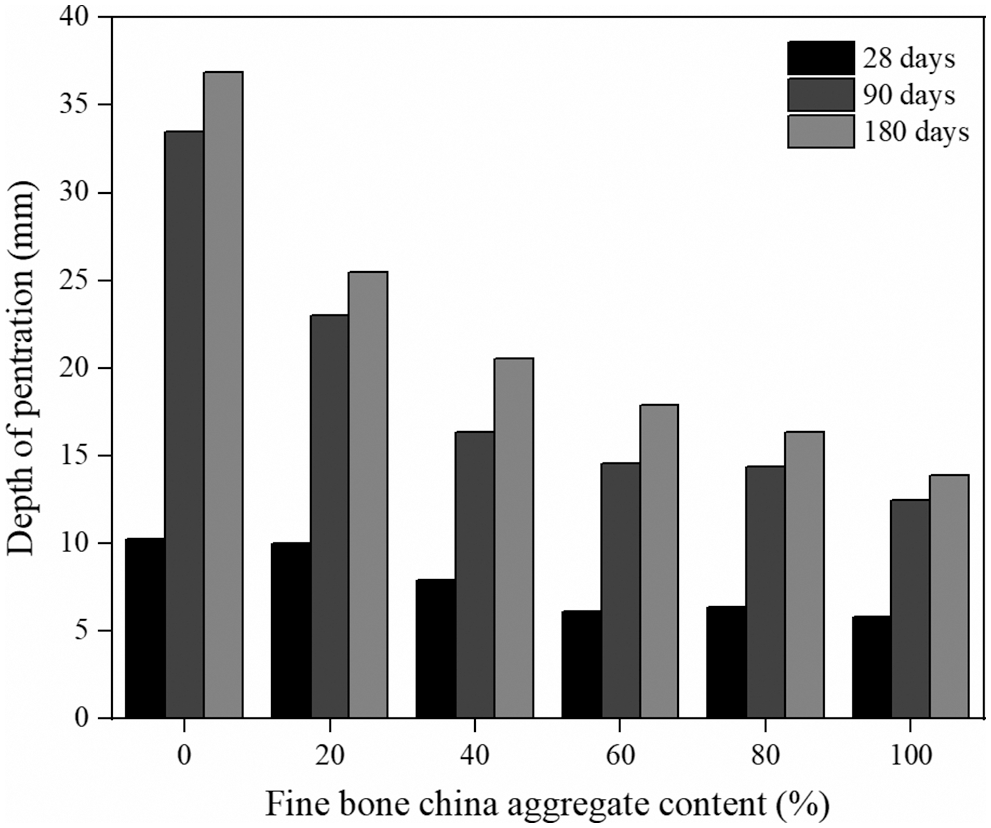
Figure 27: Chloride penetration depth for concrete with fine bone china ceramic aggregates. Adapted with permission from reference [9], Copyright © 2019, Elsevier B.V.
There were no unified research results on the effect of ceramic as coarse aggregates on the resistance to chloride penetration of concrete. Some research results showed that when ceramic waste was used to replace coarse aggregates, the chloride ion diffusion capacity of concrete was significantly reduced [20]. Wu et al. [119] found that the resistance to chloride penetration of concrete with 50%, 70%, and 100% coarse semi-porcelain aggregates were consistent with that of ordinary concrete. This was due to the excellent bonding between the rough surface of semi-porcelain aggregates and cement pastes, and unconnected pores in semi-porcelain aggregates blocked the penetration channels. However, in contrast with that of the control specimen, the chloride permeability of concrete in which sanitary ware waste replaced 20% and 25% of the coarse aggregates increased by 4% and 8%, respectively [22]. As shown in Fig. 28, chloride concentration reduced with penetration depth and decreased to zero at 25, 26 and 27 mm when sanitary ware waste replaced 0%, 20%, and 30% of the coarse aggregates, respectively. At the same depth, the chloride concentration of concrete containing sanitary ware aggregates was higher than that of the reference concrete, which indicated a reduction in durability. Similarly, the chloride penetration resistance of high strength concrete containing sanitary ware aggregates was lower than that of high strength concrete without sanitary ware aggregates [29]. Certainly, the durability of ceramic aggregate concrete was also improved by mineral admixtures. It was worth noting that, for low pozzolanic activity, the ability of fly ash to reduce chloride ion penetration was not shown in the early curing. The reduction effect was better when fly ash and silica fume were utilized together. This was attributed to the smaller size of silica fume particles than cement particles; moreover, it could fill the pores in concrete and reacted quickly with Ca(OH)2, generating gels that improved the microstructure of concrete. If the surface strengthening technology could be used to improve the performance of coarse ceramic aggregates based on using mineral admixture, the pores of ITZ would be greatly reduced, which made ITZ denser and durability of concrete better [120].

Figure 28: Chloride penetration profiles in concrete with coarse sanitary ware aggregates. Adapted with permission from reference [22], Copyright © 2016, Elsevier B.V.
Freeze-thaw resistance is also a considerable index for estimating the durability of concrete. Mass loss, strength loss, and relative dynamic elastic modulus usually occur after freeze-thaw cycles. The freeze-thaw resistance of concrete is easily affected by the inherent characteristics of concrete (porosity, water content, and aggregate type) and the external environment (cold climate and working environment). In general, moderate ceramic powder contributes to an improvement in the frost resistance of concrete. The maximum number of freeze-thaw cycles of concrete with ceramic powder instead of 30% cement was the highest in the quick frost experiment of [121]. In addition, Peng et al. [122] reported a 20% optimum replacement ratio for freeze-thaw resistance. As shown in Fig. 29, in terms of the relative dynamic modulus of elasticity, that of recycled aggregate concrete with 10% ceramic powder was similar to that of the reference concrete and that of recycled aggregate concrete with 20% ceramic powders was the highest after the same freeze-thaw cycles. However, a replacement ratio of more than 20% was disadvantageous. For replacement levels less than 20%, the filling effect of ceramic powder was poor, while with replacement levels greater than 20%, the reduction in cement led to a reduction in the Ca(OH)2 reacting with ceramic powders, which had a negative impact on the formation of a dense concrete structure and affected the freeze-thaw resistance. The mass loss ratio also exhibited a similar trend. In Fig. 29, at the beginning of the freeze-thaw cycle, the mass loss rate of each specimen group increased negatively. This was because external water intruding into the recycled aggregate concrete owing the large pores of the recycled aggregates and some microcracks in the concrete improved the quality of each group of specimens [123].
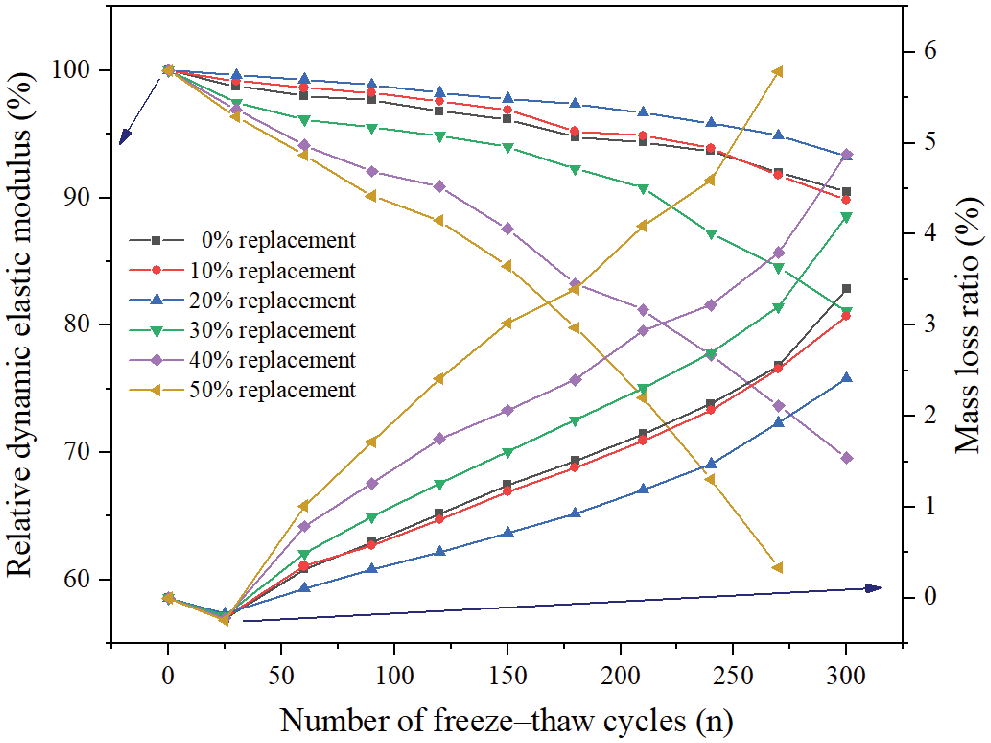
Figure 29: Variation of dynamic elastic modulus and mass loss rate of ceramic powder concrete. Adapted with permission from reference [22], Copyright © 2016, Elsevier B.V.
The addition of fine bone china ceramic aggregates was considered to improve freeze-thaw resistance. As shown in Fig. 30, the resistance to mass loss from the freeze and thaw of concrete with a W/B ratio of 0.55 was best. During the freeze-thaw cycles, the water in concrete expanded and contracted constantly, which led to mortar falling off the concrete surface owing to the stress it experienced. The ice lens formed by the higher porosity could relieve the stress on the mortar. The presence of fine bone china ceramic aggregates increased the pores in concrete and the higher W/B ratio corresponded to a higher porosity, which explained the higher frost resistance of ceramic aggregate concrete and why the highest frost resistance was achieved with concrete having the highest W/B ratio. Moreover, the loss of compressive strength should be attributed to poor bonding between pastes and aggregates owing to repeated changes in internal stress. The strength loss of ceramic aggregate concrete was lower than that of control concrete for excellent bonding between pastes and aggregates caused by more gels from pozzolanic reaction of fine bone china ceramic aggregates. The research reported the best freeze-thaw resistance of ceramic concrete was achieved when ceramic tiles replaced 20% of the sand, and a higher replacement ratio would reduce the durability of ceramic concrete [124]. Chen et al. [125] tested the freeze-thaw resistance of concrete with ceramic tiles substituting 30%, 50%, 70%, and 100% of the sand and gravel. The results revealed that their maximum number of freeze-thaw cycles were same (50 times). Wang et al. [126] found that beyond 25 freeze-thaw cycles, the strength loss of concrete containing coarse ceramic tile aggregates was lower than that of ordinary concrete, while the mass loss of concrete containing coarse ceramic tile aggregates was higher than that of ordinary concrete. Furthermore, the durability of concrete containing ceramic waste as fine and coarse aggregates was also studied [54,127]. Ogrodnik et al. [19] further investigated the impact of different cements on the freeze-thaw resistance of concrete with sanitary ware as the only aggregate and reported that the frost resistance of concrete with Aluminous cement was worse than that of concrete Portland cement.
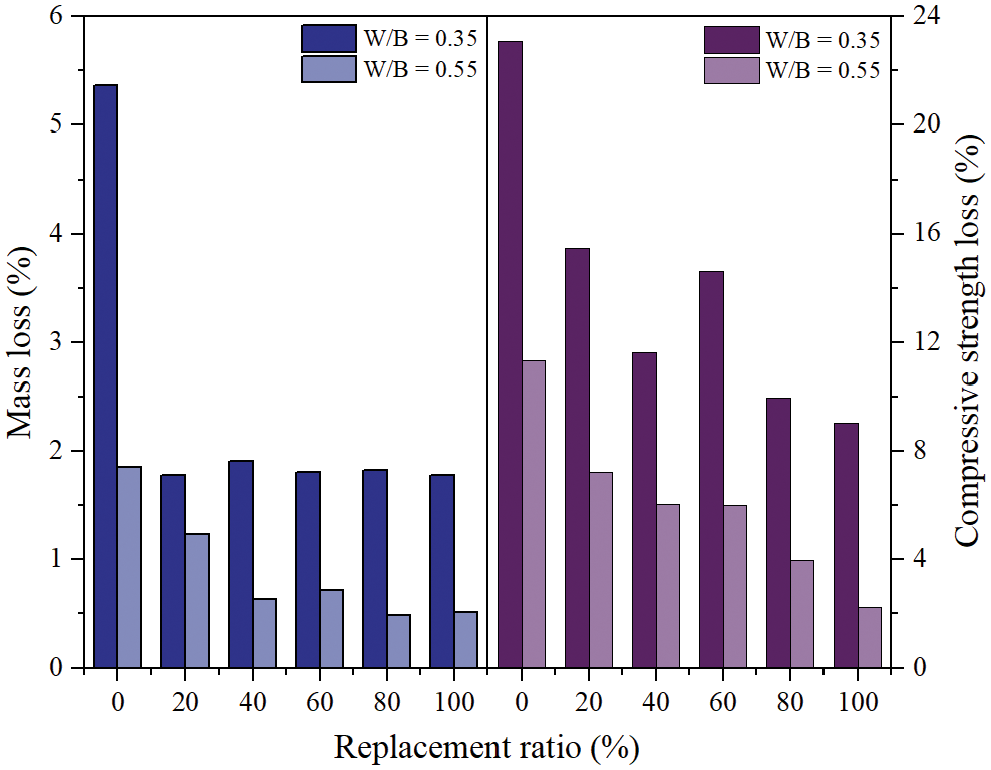
Figure 30: The mass loss and compressive strength loss for concrete with fine bone china ceramic. Adapted with permission from reference [9], Copyright © 2019, Elsevier B.V.
5.4 High Temperature Resistance
The decline in the strength, quality, and density of concrete at high temperatures often poses a great threat to the safety of concrete structures. Therefore, it is necessary to evaluate the high-temperature resistance of concrete. The high-temperature resistance of ceramic concrete is higher than that of ordinary concrete because of its sintering process at elevated temperatures. The thermal conductivity and thermal diffusivity of concrete with brick powder were lower than those of the reference concrete and gradually decreased with the brick powder content. This meant that concrete with ceramic powder was a superior thermal and thermal insulation material [30,67].
In Fig. 31, the increasing and then decreasing trend of compressive strength with the temperature of concrete containing fine tableware aggregates was consistent with that of concrete without fine tableware aggregates. The increase in compressive strength at 200°C could be attributed to consumption of Ca(OH)2 to generate C-S-H gels, which was beneficial for the microstructure of concrete. Cracks appeared on the surface of ordinary concrete exposed to a temperature of 500°C, whereas cracks were not observed in concrete containing fine tableware aggregates even at 800°C [31]. Similar behavior also occured in concrete with coarse ceramic aggregates.
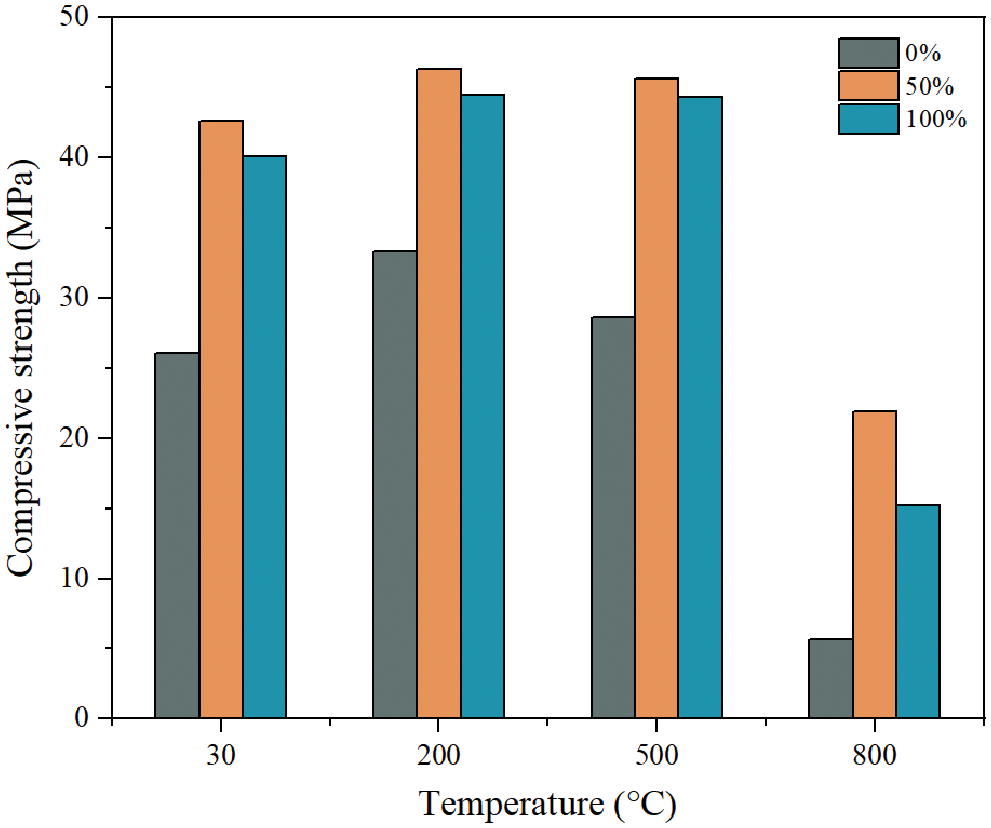
Figure 31: Compressive strength of fine tableware concrete exposed to temperature. Adapted with permission from reference [31], Copyright © 2018, John Wiley & Sons, Inc.
Fig. 32 presents the relative compressive strength of concrete containing different contents of coarse ceramic aggregates exposed to different temperatures. In contrast with the reference sample, the residual strength of concrete containing ceramic waste as coarse aggregates after high temperature exposure increased significantly and tended to increase with the replacement ratio of ceramic waste. This was due to the following reasons: (i) Ceramic aggregates were more stable, and their mass loss was lower than that of natural aggregates at elevated temperatures; (ii) the thermal expansion coefficient of ceramic aggregates was much lower than that of gravel; thus, the volume change of ceramic aggregates could adapt to the deformation of the matrix, resulting in a lower internal stress. Thus, crack formation in the concrete matrix with ceramic aggregates was slowed down. As expected, the use of ceramic waste to replace sand and gravel simultaneously improved the high-temperature resistance as well [33,64]. Surprisingly, aluminum cement containing ceramic aggregates would maintain its shape and high strength at 1000°C [56]. Moreover, it was observed that the specimen size and the time required to achieve the desired temperature had a significant effect on the residual mechanical performance of ceramic aggregate concrete [128].
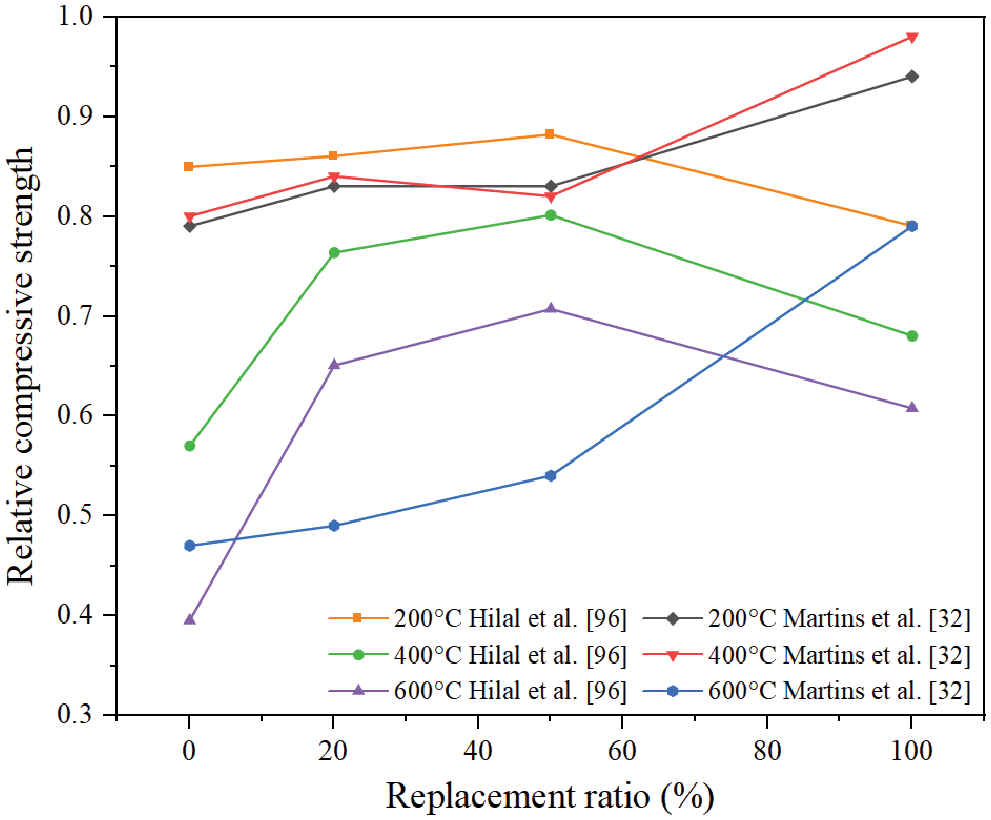
Figure 32: Variation of relative compressive strength of concrete with content of coarse ceramic aggregates after high temperature [32,96]. Adapted with permission from reference [32], Copyright © 2016, John Wiley & Sons, Inc., and reference [96], Copyright © 2020, Springer Nature Switzerland AG
Concrete is usually exposed to the air and CO2 continuously reacts with Ca(OH)2 in the concrete, resulting in reduction of internal alkalinity of concrete and occurrence of carbonation. Carbonation phenomenon is common in concrete engineering. In order to ensure sufficient life of concrete, the carbonation resistance of concrete cannot be ignored. In the study of Li [13], the carbonation depth of concrete first decreased and then increased with the increase in replacement rate of ceramic powders (Fig. 33). 10%–30% replacement rate of ceramic powders was more recommended. A suitable content of ceramic powders played a filling role and increased compactness and uniformity of concrete. Therefore, the diffusion of CO2 in the concrete could be suppressed. Ceramic powders concrete produced less Ca(OH)2 during the hydration process, which meant that the alkalinity of concrete with ceramic powders was lower than that of control concrete. In addition, the pozzolanic activity of ceramic powders was beneficial to secondary hydration reaction of Ca(OH)2 produced in process of cement and ceramic powder hydration. which further reduced the alkalinity of concrete with ceramic powders. The increase in replacement rate of ceramic powders led to decrease in alkalinity of concrete, which caused reduction in carbonation resistance of concrete. The chemical activity effect of 40% ceramic powders was stronger than filling effect of ceramic powders, which resulted in the increase in carbonation depth of ceramic concrete. However, Cheng et al. [129] reported that the carbonation depth of concrete increased monotonically with increasing ceramic powder content (Fig. 33). This may be due to the fact that the pozzolanic activity of ceramic powders was higher than that of ceramic powders used in the study of Li [13].
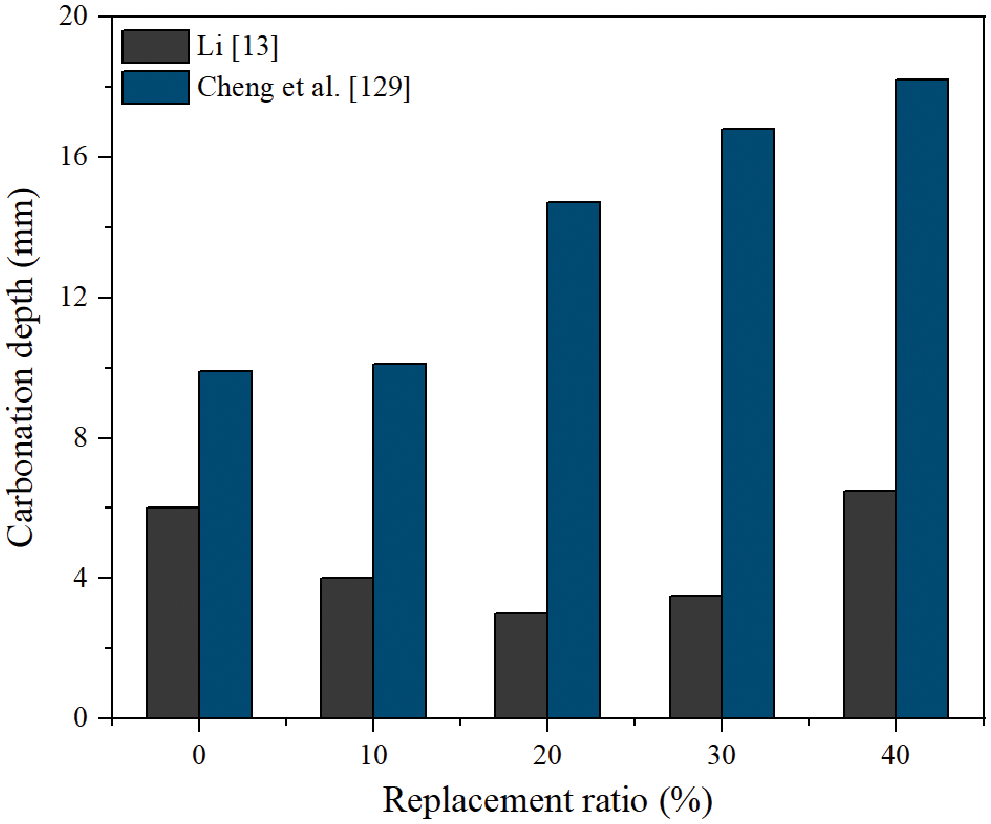
Figure 33: Carbonation depth of concrete with ceramic powders [13,129]. Adapted with permission from reference [13], Copyright © 2010, China Ceramic, and reference [129], Copyright © 2014, Elsevier B.V.
Lu et al. [130] believed that the carbonation depth of concrete containing 25% of fine ceramic fine aggregates was different under different conditions (strength grade and curing age). For concrete of same strength grade, the carbonation depth increased with curing age. And the carbonation depth increased rapidly with curing age at the beginning, and then slowed down. After curing age exceeding 180 d, the magnitude of increase was significantly reduced. For concrete of the same curing age, the lower strength grade of concrete, the greater carbonization depth. As the curing age increased, the pores or channels in concrete were filled or blocked by CaCO3 generated by carbonation. Then the carbonization rate became slower. The higher the strength grade of concrete, the denser its structure, which made it difficult for CO2 to enter concrete. This effectively reduced carbonation depth of concrete. It was also reported that larger carbonation depth of concrete was consistent with higher content of coarse ceramic aggregates [131]. The glazed surface of coarse ceramic aggregates resulted in the formation of many micro-cracks in concrete, which was conducive to diffusion of CO2 and reduced carbonation resistance of concrete. The more ceramic aggregates replaced natural aggregates, the more micro-cracks were produced, leading to greater carbonation depth of concrete.
6 Recommendations for Future Research
(1) There may be conflicts between the mechanical properties of ceramic concrete, and these differences are attributed to the types of ceramic. Furthermore, various strength prediction formulas for ceramic concrete are not universally applicable. Therefore, a significant amount of research must be carried out in order to obtain prediction formulas of general significance.
(2) With the development of green construction, geopolymer can be regarded to be a suitable green substitution for cement. Therefore, the further investigation of properties of the geopolymer concrete or composites containing ceramic waste can be conducted.
(3) Several economic, environmental and technical advantages can be obtained by using large quantities of ceramic waste in concrete. Some ceramic aggregate improvement techniques should be developed to increase mechanical strength of ceramic concrete. The detailed analysis at the microscopic level that might contribute to improving mechanical strength should be carried out.
(4) The behavior of ceramic concrete under fire or high temperature can be further studied. The high temperature damage mechanism needs to be elaborated.
The pozzolanic activity of ceramic waste, workability, mechanical properties, and durability of ceramic concrete are discussed in this paper. The following conclusions can be drawn based on the results of this review:
(1) Ceramic waste exhibited pozzolanic activity. The superior mechanical properties and durability of ceramic waste were apparent. These characteristics made it possible for ceramic waste to act as a substitute for cement or natural aggregates in concrete. Recycling of ceramic waste was beneficial to the environment and green development of concrete. Moreover, the addition of ceramic powder improved the workability of concrete because fine ceramic particles filling concrete pastes could release more free water. However, ceramic waste as fine or coarse aggregates may increase or decrease the slump value of concrete.
(2) In addition to compressive property, other mechanical properties of concrete with ceramic powders were lower than those of ordinary concrete. A high content of ceramic powders also reduced the compressive strength of concrete. Fine or coarse ceramic aggregates did not significantly increase or decrease the mechanical strength of concrete. Bone china as aggregate for concrete improved its tensile strength and elastic modulus. In addition, the tensile and flexural strengths of ceramic concrete could be improved by using appropriate fibers.
(3) When ceramic waste was used as an aggregate, the water absorption obviously increased. The partial replacement of cement or sand with ceramic waste reduced the chloride permeability of concrete. The appropriate amount of ceramic waste added to concrete did not have a negative impact on the freeze-thaw resistance of concrete. Moreover, the elevated temperature resistance of ceramic concrete was higher than that of traditional concrete. The carbonation resistance of concrete containing coarse ceramic aggregates was lower than that of ordinary concrete.
As an alternative to cement or aggregates, ceramic waste has potential applications in production of concrete. The review of the mechanical properties and durability of concrete with ceramic waste lays a solid foundation for further discussion and analysis of ceramic concrete in the future.
Funding Statement: The authors would like to acknowledge the financial support received from Natural Science Foundation of Henan (Grant No. 212300410018), National Natural Science Foundation of China (Grant No. U2040224), Program for Innovative Research Team (in Science and Technology) in University of Henan Province of China (Grant No. 20IRTSTHN009), and the Research and Develop Project of China Construction Seventh Engineering Division Co., Ltd. (Grant No. CSCEC7b-2021-Z-11).
Conflicts of Interest: The authors declare that they have no conflicts of interest to report regarding the present study.
References
1. Zhang, P., Wang, K., Wang, J., Guo, J., Hu, S. et al. (2020). Mechanical properties and prediction of fracture parameters of geopolymer/alkali-activated mortar modified with PVA fiber and nano-SiO2. Ceramic International, 46(12), 20027–20037. [Google Scholar]
2. Senthamarai, R., Manoharan, P. D. (2005). Concrete with ceramic waste aggregate. Cement & Concrete Composites, 27(9–10), 910–913. [Google Scholar]
3. Kannan, D. M., Aboubakr, S. H., El-Dieb, A. S., Taha, M. M. R. (2017). High performance concrete incorporating ceramic waste powder as large partial replacement of Portland cement. Construction and Building Materials, 144, 35–41. [Google Scholar]
4. Zhang, P., Wang, K., Wang, J., Guo, J., Ling, Y. (2021). Macroscopic and microscopic analyses on mechanical performance of metakaolin/flyash based geopolymer mortar. Journal of Cleaner Production, 294, 5126193. [Google Scholar]
5. Wang, L., Luo, R., Zhang, W., Jin, M., Tang, S. (2021). Effects of fineness and content of phosphorus slag on cement hydration, permeability, pore structure and fractal dimension of concrete. Fractals, 29(2), 2140004. [Google Scholar]
6. Gao, Z., Zhang, P., Wang, J., Wang, K., Zhang, T. (2022). Interfacial properties of geopolymer mortar and concrete substrate: Effect of polyvinyl alcohol fiber and nano-SiO2 contents. Construction and Building Materials, 315, 125735. [Google Scholar]
7. Li, L., Liu, W., You, Q., Chen, M., Zeng, Q. (2020). Waste ceramic powder as a pozzolanic supplementary filler of cement for developing sustainable building materials. Journal of Cleaner Production, 259, 120853. [Google Scholar]
8. Wang, L., Guo, F. X., Yang, H. M., Wang, Y. (2021). Comparison of fly ash, PVA fiber, MgO and shrinkage-reducing admixture on the frost resistance of face slab concrete via pore structural and fractal analysis. Fractals, 29(2), 2140002. [Google Scholar]
9. Siddique, S., Chaudhary, S., Shrivastava, S., Gupta, T. (2019). Sustainable utilisation of ceramic waste in concrete: Exposure to adverse conditions. Journal of Cleaner Production, 210, 246–255. [Google Scholar]
10. Torkittikul, P., Chaipanich, A. (2010). Utilization of ceramic waste as fine aggregate within Portland cement and fly ash concretes. Cement & Concrete Composites, 32(6), 440–449. [Google Scholar]
11. Jeronimo, V. L., Meira, G. R., Pinto da Silva Filho, L. C. (2018). Performance of self-compacting concretes with wastes from heavy ceramic industry against corrosion by chlorides. Construction and Building Materials, 169, 900–910. DOI 10.1016/j.conbuildmat.2018.03.034. [Google Scholar] [CrossRef]
12. Pacheco-Torgal, F., Jalali, S. (2011). Compressive strength and durability properties of ceramic wastes based concrete. Materials and Structures, 44(1), 155–167. DOI 10.1617/s11527-010-9616-6. [Google Scholar] [CrossRef]
13. Li, L. (2010). Study on the application of ceramic waste powder in concrete. China Ceramics, 46(5), 19–21. [Google Scholar]
14. Kulovana, T., Vejmelkova, E., Keppert, M., Rovnanikova, P., Kersner, Z. et al. (2016). Mechanical, durability and hygrothermal properties of concrete produced using Portland cement-ceramic powder blends. Structural Concrete, 17(1), 105–115. DOI 10.1002/suco.201500029. [Google Scholar] [CrossRef]
15. Shi, Z., Wang, L. (2012). Utilization of ceramic polishing brick powder in C30 concrete. Concrete, 35(3), 138–140. [Google Scholar]
16. Behforouz, B., Memarzadeh, P., Eftekhar, M., Fathi, F. (2020). Regression and ANN models for durability and mechanical characteristics of waste ceramic powder high performance sustainable concrete. Computers and Concrete, 25(2), 119–132. [Google Scholar]
17. Heidari, A., Tavakoli, S., Tavakoli, D. (2019). Reusing waste ceramic and waste sanitary ware in concrete as pozzolans with nano-silica and metakaolin. International Journal of Sustainable Construction Engineering and Technology, 10(1), 55–67. DOI 10.30880/ijscet.2019.10.01.006. [Google Scholar] [CrossRef]
18. Garcia-Gonzalez, J., Rodriguez-Robles, D., Juan-Valdes, A., Moran-del Pozo, J. M., Ignacio Guerra-Romero, M. (2015). Ceramic ware waste as coarse aggregate for structural concrete production. Environmental Technology, 36(23), 3050–3059. DOI 10.1080/09593330.2014.951076. [Google Scholar] [CrossRef]
19. Ogrodnik, P., Szulej, J. (2018). The assessment of possibility of using sanitary ceramic waste as concrete aggregate-determination of the basic material characteristics. Applied Sciences, 8(7), 1205. DOI 10.3390/app8071205. [Google Scholar] [CrossRef]
20. Pacheco-Torgal, F., Jalali, S. (2010). Reusing ceramic wastes in concrete. Construction and Building Materials, 24(5), 832–838. DOI 10.1016/j.conbuildmat.2009.10.023. [Google Scholar] [CrossRef]
21. Medina, C., Juan, A., Frias, M., Sanchez de Rojas, M. I., Moran, J. M. et al. (2011). Characterization of concrete made with recycled aggregate from ceramic sanitary ware. Materiales de Construccion, 61(304), 533–546. DOI 10.3989/mc.2011.59710. [Google Scholar] [CrossRef]
22. Medina, C., Sanchez de Rojas, M. I., Thomas, C., Polanco, J. A., Frias, M. (2016). Durability of recycled concrete made with recycled ceramic sanitary ware aggregate Inter-indicator relationships. Construction and Building Materials, 105(1), 480–486. DOI 10.1016/j.conbuildmat.2015.12.176. [Google Scholar] [CrossRef]
23. Rajprasad, J., Sarath, B. K., Pannirselvam, N., (2020). Experimental investigation on partially additional of coarse aggregate with ceramic in concrete. IOP Conference Series: Materials Science and Engineering, 912(6), 062074. DOI 10.1088/1757-899X/912/6/062074. [Google Scholar] [CrossRef]
24. Passos, L., Moreno Junior, A. L., Marmorato Gomes, C. E. (2020). Durability of concrete produced with coarse aggregate from red ceramic waste. Materia-Rio de Janeiro, 25(2). [Google Scholar]
25. Xu, K., Fang, W., Chen, M., Ding, X. (2014). On the mechanical properties of ceramic recycled coarse aggregate concrete. Journal of Experimental Mechanics, 29(4), 474–480. [Google Scholar]
26. Alves, A. V., Vieira, T. F., de Brito, J., Correia, J. R. (2014). Mechanical properties of structural concrete with fine recycled ceramic aggregates. Construction and Building Materials, 64(4), 103–113. DOI 10.1016/j.conbuildmat.2014.04.037. [Google Scholar] [CrossRef]
27. Zareei, S. A., Ameri, F., Bahrami, N., Shoaei, P., Musaeei, H. R. et al. (2019). Green high strength concrete containing recycled waste ceramic aggregates and waste carpet fibers: Mechanical, durability, and microstructural properties. Journal of Building Engineering, 26, 100914. DOI 10.1016/j.jobe.2019.100914. [Google Scholar] [CrossRef]
28. Amin, M., Tayeh, B. A., Agwa, I. S. (2020). Effect of using mineral admixtures and ceramic wastes as coarse aggregates on properties of ultrahigh-performance concrete. Journal of Cleaner Production, 273(4), 123073. DOI 10.1016/j.jclepro.2020.123073. [Google Scholar] [CrossRef]
29. Mousavi, S. Y., Tavakkoli, A., Jahanshahi, M., Dankoub, A. (2020). Performance of high-strength concrete made with recycled ceramic aggregates. International Journal of Engineering, 33(6), 1085–1093. [Google Scholar]
30. Vejmelková, E., Keppert, M., Rovnaníková, P., Ondráček, M., Keršner, Z. et al. (2012). Properties of high performance concrete containing fine-ground ceramics as supplementary cementitious material. Cement & Concrete Composites, 34(1), 55–61. DOI 10.1016/j.cemconcomp.2011.09.018. [Google Scholar] [CrossRef]
31. Rajawat, D., Siddique, S., Shrivastava, S., Chaudhary, S., Gupta, T. (2018). Influence of fine ceramic aggregates on the residual properties of concrete subjected to elevated temperature. Fire and Materials, 42(7), 834–842. [Google Scholar]
32. Martins, D. J., Correia, J. R., de Brito, J. (2016). The effect of high temperature on the residual mechanical performance of concrete made with recycled ceramic coarse aggregates. Fire and Materials, 40(2), 289–304. [Google Scholar]
33. Sun, Q., Cao, W., Xue, H., Su, Q. (2011). Microstructure and finite element analysis about ceramic concrete after high temperature. Advanced Materials Research, 261–263, 247–250. [Google Scholar]
34. Xiao, J., Li, W., Poon, C. (2012). Recent studies on mechanical properties of recycled aggregate concrete in China—A review. Science China-Technological Sciences, 55(6), 1463–1480. [Google Scholar]
35. Huda, S. B., Alam, M. S. (2014). Mechanical behavior of three generations of 100% repeated recycled coarse aggregate concrete. Construction and Building Materials, 65, 574–582. [Google Scholar]
36. El-Dieb, A. S., Kanaan, D. M. (2018). Ceramic waste powder an alternative cement replacement—Characterization and evaluation. Sustainable Materials and Technologies, 17, e00063. DOI 10.1016/j.susmat.2018.e00063. [Google Scholar] [CrossRef]
37. ASTM-C618 (2017). Standard specification for coal fly ash and raw or calcined natural pozzolan for use in concrete. West Conshohocken, Pennsylvania: ASTM International. [Google Scholar]
38. Gonzalez-Corominas, A., Etxeberria, M. (2014). Properties of high performance concrete made with recycled fine ceramic and coarse mixed aggregates. Construction and Building Materials, 68, 618–626. DOI 10.1016/j.conbuildmat.2014.07.016. [Google Scholar] [CrossRef]
39. Pitarch, A. M., Reig, L., Tomas, A. E., Lopez, F. J. (2019). Effect of tiles, bricks and ceramic sanitary-ware recycled aggregates on structural concrete properties. Waste and Biomass Valorization, 10(6), 1779–1793. DOI 10.1007/s12649-017-0154-0. [Google Scholar] [CrossRef]
40. Siddique, S., Shrivastava, S., Chaudhary, S. (2018). Influence of ceramic waste as fine aggregate in concrete: Pozzolanic, XRD, FT-IR, and NMR investigations. Journal of Materials in Civil Engineering, 30(9), 04018227. DOI 10.1061/(ASCE)MT.1943-5533.0002438. [Google Scholar] [CrossRef]
41. Higashiyama, H., Yagishita, F., Sano, M., Takahashi, O. (2012). Compressive strength and resistance to chloride penetration of mortars using ceramic waste as fine aggregate. Construction and Building Materials, 26(1), 96–101. DOI 10.1016/j.conbuildmat.2011.05.008. [Google Scholar] [CrossRef]
42. Lavat, A. E., Trezza, M. A., Poggi, M. (2009). Characterization of ceramic roof tile wastes as pozzolanic admixture. Waste Management, 29(5), 1666–1674. DOI 10.1016/j.wasman.2008.10.019. [Google Scholar] [CrossRef]
43. Cheng, Y., Huang, F., Li, G., Qin, Z. (2013). Evaluation on activity of ceramic polishing powder and its effect on compressive strength of concrete. Journal of Northeastern University (Natural Science), 34(10), 1499–1503. [Google Scholar]
44. Qu, X., Zhao, X. (2016). Preparation of non-autoclaved aerated concrete using polishing ceramic tile waste. Journal of Materials Science and Engineering, 34(2), 229–236. [Google Scholar]
45. BS EN 196-5-2011 (2011). BSI, Methods of testing cement–Part 5: Pozzolanicity test for pozzolanic cement. London, UK: British Standards Institution. [Google Scholar]
46. Awoyera, P. O., Akinmusuru, J. O., Moncea, A. (2017). Hydration mechanism and strength properties of recycled aggregate concrete made using ceramic blended cement. Cogent Engineering, 4(1), 1282667. DOI 10.1080/23311916.2017.1282667. [Google Scholar] [CrossRef]
47. Brekailo, F., Pereira, E., Pereira, E., Hoppe Filho, J., Medeiros, M. H. F. D. (2019). Evaluation of the reactive potential of additions of red ceramic waste and comminuted concrete of CDW in cement matrix. Ceramic, 65(375), 351–358. DOI 10.1590/0366-69132019653752552. [Google Scholar] [CrossRef]
48. Xu, K., Huang, W., Zhang, L., Fu, S., Chen, M. et al. (2021). Mechanical properties of low-carbon ultrahigh-performance concrete with ceramic tile waste powder. Construction and Building Materials, 287(8), 123036. DOI 10.1016/j.conbuildmat.2021.123036. [Google Scholar] [CrossRef]
49. Aly, S. T., El-Dieb, A. S., Taha, M. R. (2019). Effect of high-volume ceramic waste powder as partial cement replacement on fresh and compressive strength of self-compacting concrete. Journal of Materials in Civil Engineering, 31(2), 04018374. DOI 10.1061/(ASCE)MT.1943-5533.0002588. [Google Scholar] [CrossRef]
50. El-Dieb, A. S., Taha, M. R., Kanaan, D., Aly, S. T. (2018). Ceramic waste powder: From landfill to sustainable concretes. Proceedings of the Institution of Civil Engineers-Construction Materials, 171(3), 109–116. DOI 10.1680/jcoma.17.00019. [Google Scholar] [CrossRef]
51. Subasi, S., Ozturk, H., Emiroglu, M. (2017). Utilizing of waste ceramic powders as filler material in self-consolidating concrete. Construction and Building Materials, 149(3), 567–574. DOI 10.1016/j.conbuildmat.2017.05.180. [Google Scholar] [CrossRef]
52. Aly, S. T., El-Dieb, A. S., Taha, M. R. (2018). Ceramic waste powder for eco-friendly self-compacting concrete (SCC). Advances in Civil Engineering Materials, 7(1), 426–446. DOI 10.1520/ACEM20180043. [Google Scholar] [CrossRef]
53. Huseien, G. F., Sam, A. R. M., Shah, K. W., Mirza, J. (2020). Effects of ceramic tile powder waste on properties of self-compacted alkali-activated concrete. Construction and Building Materials, 236(2), 117574. DOI 10.1016/j.conbuildmat.2019.117574. [Google Scholar] [CrossRef]
54. Ulewicz, M., Halbiniak, J. (2016). Application of waste from utilitarian ceramics for production of cement mortar and concrete. Physicochemical Problems of Mineral Processing, 52(2), 1002–1010. [Google Scholar]
55. Johnson Daniel, R., Sangeetha, S. P. (2021). Experimental study on concrete using waste ceramic as partial replacement of aggregate. Materials Today: Proceedings, 45, 6603–6608. [Google Scholar]
56. Halicka, A., Ogrodnik, P., Zegardlo, B. (2013). Using ceramic sanitary ware waste as concrete aggregate. Construction and Building Materials, 48(4), 295–305. DOI 10.1016/j.conbuildmat.2013.06.063. [Google Scholar] [CrossRef]
57. Sato, R., Shigematsu, A., Nukushina, T., Kimura, M. (2011). Improvement of properties of Portland blast furnace cement type B concrete by internal curing using ceramic roof material waste. Journal of Materials in Civil Engineering, 23(6), 777–782. DOI 10.1061/(ASCE)MT.1943-5533.0000232. [Google Scholar] [CrossRef]
58. Peter, D. M., Sam, A. R. M., Awane, A. Z., Loo, P. S., Jusoh, W. A. W. et al. (2020). Influence of industrial ceramic waste aggregates on elastic properties of concrete. International Journal of Integrated Engineering, 12(4), 259–265. [Google Scholar]
59. Yahya, N., Razak, S. M. S., Othman, M. K., Noor, S. N. A. M., Muhamad, K. et al. (2020). Mechanical and rheological properties of concrete with ceramic tile waste as partial replacement of fine aggregate. IOP Conference Series: Materials Science and Engineering, 743(1), 12033–12036. DOI 10.1088/1757-899X/743/1/012033. [Google Scholar] [CrossRef]
60. Rashid, K., Razzaq, A., Ahmad, M., Rashid, T., Tariq, S. (2017). Experimental and analytical selection of sustainable recycled concrete with ceramic waste aggregate. Construction and Building Materials, 154(11), 829–840. DOI 10.1016/j.conbuildmat.2017.07.219. [Google Scholar] [CrossRef]
61. Guendouz, M., Boukhelkhal, D. (2019). Properties of flowable sand concrete containing ceramic wastes. Journal of Adhesion Science and Technology, 33(24), 2661–2683. DOI 10.1080/01694243.2019.1653594. [Google Scholar] [CrossRef]
62. Peter, D. M., Awang, A. Z., Sam, A. R. M., Ma, C. K., Loo, P. et al. (2020). Eco-efficient concrete containing recycled ceramic wastes aggregate. IOP Conference Series: Materials Science and Engineering, 849(1), 012035. DOI 10.1088/1757-899X/849/1/012035. [Google Scholar] [CrossRef]
63. Huang, B., Dong, Q., Burdette, E. G. (2009). Laboratory evaluation of incorporating waste ceramic materials into Portland cement and asphaltic concrete. Construction and Building Materials, 23(12), 3451–3456. DOI 10.1016/j.conbuildmat.2009.08.024. [Google Scholar] [CrossRef]
64. Canbaz, M. (2016). The effect of high temperature on concrete with waste ceramic aggregate. Iranian Journal of Science and Technology-Transactions of Civil Engineering, 40(1), 41–48. DOI 10.1007/s40996-016-0002-7. [Google Scholar] [CrossRef]
65. Wu, B., Xie, X., Huang, Y., Tan, Q., Huang, D. (2014). Effects of mineral admixtures on properties of ceramic coarse aggregate concrete. Bulletin of the Chinese Ceramic Society, 33(6), 1490–1496. [Google Scholar]
66. Heidari, A., Tavakoli, D. (2013). A study of the mechanical properties of ground ceramic powder concrete incorporating nano-SiO2 particles. Construction and Building Materials, 38(9), 255–264. DOI 10.1016/j.conbuildmat.2012.07.110. [Google Scholar] [CrossRef]
67. Vejmelkova, E., Konakova, D., Kulovana, T., Hubacek, A., Cerny, R. (2014). Mechanical and thermal properties of moderate-strength concrete with ceramic powder used as supplementary cementitious material. Advanced Materials Research, 1054, 194–198. DOI 10.4028/www.scientific.net/AMR.1054.194. [Google Scholar] [CrossRef]
68. Atkuri, V. K., Rao, G. V. R. (2021). Strength properties of ceramic waste concrete. IOP Conference Series: Materials Science and Engineering, 1025(1), 12017–12019. DOI 10.1088/1757-899X/1025/1/012017. [Google Scholar] [CrossRef]
69. Khatib, J. M. (2005). Properties of concrete incorporating fine recycled aggregate. Cement and Concrete Research, 35(4), 763–769. DOI 10.1016/j.cemconres.2004.06.017. [Google Scholar] [CrossRef]
70. Debieb, F., Kenai, S. (2008). The use of coarse and fine crushed bricks as aggregate in concrete. Construction and Building Materials, 22(5), 886–893. DOI 10.1016/j.conbuildmat.2006.12.013. [Google Scholar] [CrossRef]
71. Pei, Q., Wang, G., Shen, Y., Zhu, M., Qu, F. (2017). Effect of waste ceramic tile recycled aggregate on mortar and concrete. Bulletin of the Chinese Ceramic Society, 36(3), 797–802. [Google Scholar]
72. Siddique, S., Shrivastava, S., Chaudhary, S. (2018). Durability properties of bone china ceramic fine aggregate concrete. Construction and Building Materials, 173(304), 323–331. DOI 10.1016/j.conbuildmat.2018.03.262. [Google Scholar] [CrossRef]
73. Shigeta, A., Ogawa, Y., Kawai, K. (2018). Microscopic investigation on concrete cured internally by using porous ceramic roof-tile waste aggregate. MATEC Web of Conferences, 195, 01004. DOI 10.1051/matecconf/201819501004. [Google Scholar] [CrossRef]
74. Siddique, S., Shrivastava, S., Chaudhary, S., Gupta, T. (2018). Strength and impact resistance properties of concrete containing fine bone china ceramic aggregate. Construction and Building Materials, 169(2), 289–298. DOI 10.1016/j.conbuildmat.2018.02.213. [Google Scholar] [CrossRef]
75. Cheng, Y., Yang, S., Zhang, J., Tong, B. (2020). Effect of substitution of ceramic fine aggregate on compressive strength of concrete. Journal of Northeastern University (Natural Science), 41(11), 1661–1666. [Google Scholar]
76. Senthamarai, R. M., Manoharan, P. D., Gobinath, D. (2011). Concrete made from ceramic industry waste: Durability properties. Construction and Building Materials, 25(5), 2413–2419. DOI 10.1016/j.conbuildmat.2010.11.049. [Google Scholar] [CrossRef]
77. Bakri, M. A., Norazian, M. N., Kamarudin, H., Salleh, M. A. A. M., Alida, A. (2013). Strength of concrete based cement using recycle ceramic waste as aggregate. Advanced Materials Research, 740, 734–738. DOI 10.4028/www.scientific.net/AMR.740.734. [Google Scholar] [CrossRef]
78. Medina, C., Sanchez de Rojas, M. I., Frias, M. (2013). Properties of recycled ceramic aggregate concretes: Water resistance. Cement & Concrete Composites, 40(3), 21–29. DOI 10.1016/j.cemconcomp.2013.04.005. [Google Scholar] [CrossRef]
79. Medina, C., Sanchez de Rojas, M. I., Frias, M. (2013). Freeze-thaw durability of recycled concrete containing ceramic aggregate. Journal of Cleaner Production, 40, 151–160. DOI 10.1016/j.jclepro.2012.08.042. [Google Scholar] [CrossRef]
80. Almeida, D. H., Freitas Grillo, R. H., Maestrelli, S. C., Del Roveri, C. (2019). Properties of concrete manufactured with use of ceramic sanitary ware waste as aggregate. Materia-Rio de Janeiro, 24(2), e-12350. DOI 10.1590/s1517-707620190002.0665. [Google Scholar] [CrossRef]
81. Soleimani, S. M., Alaqqad, A., Afrasiab, T., Jumaah, A., Behbehani, A. et al. (2020). A sustainable solution for ceramic and steel wastes in self-consolidating, high-performance concrete. IOP Conference Series: Earth and Environmental Science, 588(4), 42062–42068. DOI 10.1088/1755-1315/588/4/042062. [Google Scholar] [CrossRef]
82. Nepomuceno, M. C. S., Isidoro, R. A. S., Catarino, J. P. G. (2018). Mechanical Performance evaluation of concrete made with recycled ceramic coarse aggregates from industrial brick waste. Construction and Building Materials, 165(4), 284–294. DOI 10.1016/j.conbuildmat.2018.01.052. [Google Scholar] [CrossRef]
83. Brito, J., Pereira, A. S., Correia, J. R. (2005). Mechanical behaviour of non-structural concrete made with recycled ceramic aggregates. Cement & Concrete Composites, 27(4), 429–433. DOI 10.1016/j.cemconcomp.2004.07.005. [Google Scholar] [CrossRef]
84. González, J. S., Gayarre, F. L., Pérez, C. L. C., Ros, P. S., López, M. A. S. (2017). Influence of recycled brick aggregates on properties of structural concrete for manufacturing precast prestressed beams. Construction and Building Materials, 149(173), 507–514. DOI 10.1016/j.conbuildmat.2017.05.147. [Google Scholar] [CrossRef]
85. Bommisetty, J., Keertan, T. S., Ravitheja, A., Mahendra, K. (2019). Effect of waste ceramic tiles as a partial replacement of aggregates in concrete. Materials Today: Proceedings, 19, 875–877. [Google Scholar]
86. Anderson, D. J., Smith, S. T., Au, F. T. K. (2016). Mechanical properties of concrete utilising waste ceramic as coarse aggregate. Construction and Building Materials, 117(7), 20–28. DOI 10.1016/j.conbuildmat.2016.04.153. [Google Scholar] [CrossRef]
87. Wu, B., Wu, X., Lu, J. (2016). Preparation and properties of high-performance concrete with ceramic coarse aggregate. Materials Science Forum, 852, 1413–1420. DOI 10.4028/www.scientific.net/MSF.852.1413. [Google Scholar] [CrossRef]
88. Keshavarz, Z., Mostofinejad, D. (2019). Porcelain and red ceramic wastes used as replacements for coarse aggregate in concrete. Construction and Building Materials, 195(1), 218–230. DOI 10.1016/j.conbuildmat.2018.11.033. [Google Scholar] [CrossRef]
89. Cichocki, K., Domski, J., Katzer, J., Ruchwa, M. (2015). Static and dynamic characteristics of waste ceramic aggregate fibre reinforced concrete. Transactions of the VSB-Technical University of Ostrava, 15(2), 5–14. DOI 10.1515/tvsb-2015-0005. [Google Scholar] [CrossRef]
90. Keshavarz, Z., Mostofinejad, D. (2019). Steel chip and porcelain ceramic wastes used as replacements for coarse aggregates in concrete. Journal of Cleaner Production, 230(3), 339–351. DOI 10.1016/j.jclepro.2019.05.010. [Google Scholar] [CrossRef]
91. Shanmugam, D., Chinnasamy, K., Sampath Kumar, K. N., Elangovan, S., Raj, J. P. (2020). Eco-efficient concrete incorporating ceramic waste powder and red brick dust as an effective replacement for ordinary Portland cement and fine aggregate. IOP Conference Series: Materials Science and Engineering, 955(1), 12012–12041. DOI 10.1088/1757-899X/955/1/012041. [Google Scholar] [CrossRef]
92. Awoyera, P. O., Ndambuki, J. M., Akinmusuru, J. O., Omole, D. O. (2018). Characterization of ceramic waste aggregate concrete. HBRC Journal, 14(3), 282–287. DOI 10.1016/j.hbrcj.2016.11.003. [Google Scholar] [CrossRef]
93. Suzuki, M., Meddah, M. S., Sato, R. (2009). Use of porous ceramic waste aggregates for internal curing of high-performance concrete. Cement and Concrete Research, 39(5), 373–381. DOI 10.1016/j.cemconres.2009.01.007. [Google Scholar] [CrossRef]
94. Medina, C., Frias, M., Sanchez de Rojas, M. I. (2012). Microstructure and properties of recycled concretes using ceramic sanitary ware industry waste as coarse aggregate. Construction and Building Materials, 31(6), 112–118. DOI 10.1016/j.conbuildmat.2011.12.075. [Google Scholar] [CrossRef]
95. Awoyera, P. O., Akinmusuru, J. O., Ndambuki, J. M. (2016). Green concrete production with ceramic wastes and laterite. Construction and Building Materials, 117(3), 29–36. DOI 10.1016/j.conbuildmat.2016.04.108. [Google Scholar] [CrossRef]
96. Hilal, N. N., Mohammed, A. S., Ali, T. K. M. (2020). Properties of eco-friendly concrete contained limestone and ceramic tiles waste exposed to high temperature. Arabian Journal for Science and Engineering, 45(5), 4387–4404. DOI 10.1007/s13369-020-04482-x. [Google Scholar] [CrossRef]
97. Medina, C., Sanchez de Rojas, M. I., Frias, M. (2012). Reuse of sanitary ceramic wastes as coarse aggregate in eco-efficient concretes. Cement & Concrete Composites, 34(1), 48–54. DOI 10.1016/j.cemconcomp.2011.08.015. [Google Scholar] [CrossRef]
98. Elevado, K. J. T., Galupino, J. G., Gallardo, R. S. (2019). Compressive strength optimization of concrete mixed with waste ceramics and fly ash. International Journal of Geomate, 16(53), 135–140. [Google Scholar]
99. Katzer, J., Domski, J. (2016). Specific properties of waste ceramic aggregate concrete reinforced by steel fibre. Annual Set the Environment Protection, 18, 112–123. [Google Scholar]
100. Ray, S., Rahman, M. M., Haque, M., Hasan, M. W., Alam, M. M. (2021). Performance evaluation of SVM and GBM in predicting compressive and splitting tensile strength of concrete prepared with ceramic waste and nylon fiber. Journal of King Saud University-Engineering Sciences, 52(1), 1. DOI 10.1016/j.jksues.2021.02.009. [Google Scholar] [CrossRef]
101. Vejmelkova, E., Ondracek, M., Sedlmajer, M., Cerny, R. (2010). Fine-ground ceramics as an alternative binder in high performance concrete. WIT Transactions on the Built Environment, 112, 91–95. DOI 10.2495/HPSM10. [Google Scholar] [CrossRef]
102. Batikha, M., Ali, S. T. M., Rostami, A., Kurtayev, M. (2020). Using recycled coarse aggregate and ceramic waste to produce sustainable economic concrete. International Journal of Sustainable Engineering, 14(4), 785–799. DOI 10.1080/19397038.2020.1862353. [Google Scholar] [CrossRef]
103. Pradeep, A. R., Lingana Gowda, M. I. B. (2016). Experimental studies on the effect of ceramic fine aggregate on the strength. Journal of Mechanical Civil Engineering, 1684, 22278. [Google Scholar]
104. Siddique, S., Shrivastava, S., Chaudhary, S. (2019). Influence of ceramic waste on the fresh properties and compressive strength of concrete. European Journal of Environmental and Civil Engineering, 23(2), 212–225. DOI 10.1080/19648189.2016.1275985. [Google Scholar] [CrossRef]
105. Zegardlo, B., Brzyski, P., Rymuza, K., Bombik, A. (2018). Analysis of the effects of aggressive environments simulating municipal sewage on recycled concretes based on selected ceramic waste. Materials, 11(12), 2565. DOI 10.3390/ma11122565. [Google Scholar] [CrossRef]
106. Awoyera, P. O., Dawson, A. R., Thom, N. H., Akinmusuru, J. O. (2017). Suitability of mortars produced using laterite and ceramic wastes: Mechanical and microscale analysis. Construction and Building Materials, 148(1), 195–203. DOI 10.1016/j.conbuildmat.2017.05.031. [Google Scholar] [CrossRef]
107. Mohammed, H., Ahmed, S. (2020). Mechanical performance evaluation of concrete with waste coarse ceramic aggregate. Lecture Notes in Civil Engineering, 58, 593–605. DOI 10.1007/978-981-15-2545-2. [Google Scholar] [CrossRef]
108. Juan-Valdes, A., Rodriguez-Robles, D., Garcia-Gonzalez, J., Ignacio Guerra-Romero, M., Maria Moran-del Pozo, J. (2018). Mechanical and microstructural characterization of non-structural precast concrete made with recycled mixed ceramic aggregates from construction and demolition wastes. Journal of Cleaner Production, 180, 482–493. DOI 10.1016/j.jclepro.2018.01.191. [Google Scholar] [CrossRef]
109. Juan-Valdes, A., Garcia-Gonzalez, J., Rodriguez-Robles, D., Ignacio Guerra-Romero, M., Lopez Gayarre, F. et al. (2019). Paving with precast concrete made with recycled mixed ceramic aggregates: A viable technical option for the valorization of construction and demolition wastes (CDW). Materials, 12(1), 24. DOI 10.3390/ma12010024. [Google Scholar] [CrossRef]
110. ACI 318-11 (2014). ACI 318, Building code requirements for structural concrete and commentary. Farmington Hills: American Concrete Institute. [Google Scholar]
111. CSA A23.3-04 (2004). Design of concrete structures. Toronto, Canada: Canada Standard Association. [Google Scholar]
112. EN.1992.1.1.2004 (2004). EC-04., B.S. Institution, Eurocode 2: Design of concrete structures: Part 1–1, General rules and rules for buildings. Brussels, Belgium. [Google Scholar]
113. Sales, A. T. C., Alferes Filho, R. D. S. (2014). The effect of ceramic waste powder as active addition for concrete. Ambient Construction, 14(1), 113–125. DOI 10.1590/S1678-86212014000100010. [Google Scholar] [CrossRef]
114. Shen, Y., Wang, G., Pei, Q., Zhu, M., Qu, F. (2018). Research on compressive strength and elastic modulus of C30 waste ceramic recycled aggregate concrete. Bulletin of the Chinese Ceramic Society, 37(12), 3795–3801. [Google Scholar]
115. Li, L., Liu, W. F., You, Q. X., Chen, M. C., Zeng, Q. et al. (2020). Relationships between microstructure and transport properties in mortar containing recycled ceramic powder. Journal of Cleaner Production, 263(2), 121384. DOI 10.1016/j.jclepro.2020.121384. [Google Scholar] [CrossRef]
116. El-Dieb, A. S., Shehab, E. E. (2014). Cementless concrete using ceramic waste powder. Construction Materials and Structures, 2014, 487–494. [Google Scholar]
117. Karthikeyan, B., Dhinakaran, G. (2017). Strength and durability studies on high strength concrete using ceramic waste powder. Structural Engineering and Mechanics, 61(2), 171–181. DOI 10.12989/sem.2017.61.2.171. [Google Scholar] [CrossRef]
118. Wang, G., Tan, L., Nie, Y., Tian, B. (2012). Effect of ceramic polishing powder on the chloride permeability of concrete. Bulletin of the Chinese Ceramic Society, 31(6), 1564–1570. [Google Scholar]
119. Wu, B., Zhou, X., Chen, Y. (2015). Resistance to chloride Ion penetration for concretes with ceramic coarse aggregate. Bulletin of the Chinese Ceramic Society, 34(8), 2382–2386. [Google Scholar]
120. Chen, M., Fang, W., Xu, K., Ding, X. (2014). Test study for chloride permeability and analysis of microscopic mechanism of reinforced ceramic concrete. Concrete, 37(4), 48–50. [Google Scholar]
121. Cheng, Y., Huang, F., Xu, L., Hou, J., Li, G. (2015). Effects of ceramic polishing powder on frost resistance of concrete. Journal of Harbin Institute of Technology, 47(10), 55–58,93. [Google Scholar]
122. Peng, K., Qiao, H., Chen, K. (2020). Reliability analysis of freeze-thaw damage of recycled ceramic powder concrete. Journal of Materials in Civil Engineering, 32(9), 05020008. DOI 10.1061/(ASCE)MT.1943-5533.0003360. [Google Scholar] [CrossRef]
123. Qiao, H., Peng, K., Chen, K., Li, J., Zhu, X. (2020). Reliability analysis of freeze-thaw damage of ceramic powder recycled concrete. Materials Review, 34(5B), 10035–10040. [Google Scholar]
124. Qiao, H., Peng, K., Chen, K., Guan, L., Zhu, X. (2019). Freeze thaw cycling performance and reliability analysis of waste ceramic tile recycled aggregate concrete. Journal of Functional Materials, 50(7), 7139–7144. [Google Scholar]
125. Cheng, Y., Huang, F., Li, Y. (2012). Test research on frost resistance of waste ceramic aggregate concrete. Concrete, 35(9), 83–85. [Google Scholar]
126. Wang, J., Wang, G., Huang, D., He, X., He, X. (2014). Experimental study on preparation and performance of waste ceramic tile recycled aggregate concrete. Bulletin of the Chinese Ceramic Society, 33(11), 3000–3005. [Google Scholar]
127. Zegardlo, B., Szelag, M., Ogrodnik, P. (2016). Ultra-high strength concrete made with recycled aggregate from sanitary ceramic wastes—The method of production and the interfacial transition zone. Construction and Building Materials, 122(7), 736–742. DOI 10.1016/j.conbuildmat.2016.06.112. [Google Scholar] [CrossRef]
128. Passos, L., Moreno, A. L.Jr, Souza, A. A. A. (2020). Lightweight concrete with coarse aggregate from ceramic waste at high temperatures. IBRACON Structures and Materials Joural, 13(2), 433–454. DOI 10.1590/s1983-41952020000200012. [Google Scholar] [CrossRef]
129. Cheng, Y., Huang, F., Li, G., Xu, L., Hou, J. (2014). Test research on effects of ceramic polishing powder on carbonation and sulphate-corrosion resistance of concrete. Construction and Building Materials, 55(7), 440–446. DOI 10.1016/j.conbuildmat.2014.01.023. [Google Scholar] [CrossRef]
130. Lu, S., Zeng, Z. (2013). Experimental study on detecting compressive strength of recycled concrete using waste ceramic as fine aggregate by ult rasonic-rebound method. Concrete, 35(7), 44–49. [Google Scholar]
131. Lu, S., Zeng, Z., Wan, C. (2014). Experimental study on the carbonation regularity of recycled concrete using waste ceramic as coarse aggregate. Concrete, 36(8), 49–51. [Google Scholar]
Cite This Article
 Copyright © 2023 The Author(s). Published by Tech Science Press.
Copyright © 2023 The Author(s). Published by Tech Science Press.This work is licensed under a Creative Commons Attribution 4.0 International License , which permits unrestricted use, distribution, and reproduction in any medium, provided the original work is properly cited.


 Submit a Paper
Submit a Paper Propose a Special lssue
Propose a Special lssue View Full Text
View Full Text Download PDF
Download PDF Downloads
Downloads
 Citation Tools
Citation Tools